new posts in all blogs
Viewing: Blog Posts Tagged with: Vertigo, Most Recent at Top [Help]
Results 26 - 50 of 55
How to use this Page
You are viewing the most recent posts tagged with the words: Vertigo in the JacketFlap blog reader. What is a tag? Think of a tag as a keyword or category label. Tags can both help you find posts on JacketFlap.com as well as provide an easy way for you to "remember" and classify posts for later recall. Try adding a tag yourself by clicking "Add a tag" below a post's header. Scroll down through the list of Recent Posts in the left column and click on a post title that sounds interesting. You can view all posts from a specific blog by clicking the Blog name in the right column, or you can click a 'More Posts from this Blog' link in any individual post.

By:
Heidi MacDonald,
on 2/13/2015
Blog:
PW -The Beat
(
Login to Add to MyJacketFlap)
JacketFlap tags:
Fandom,
branding,
Twitter,
Constantine,
Vertigo,
NBC,
Comics Media,
Showbiz,
Hellblazer,
matt ryan,
#saveconstantine,
fan campaigns,
twitter tv,
News,
Television,
DC,
Add a tag
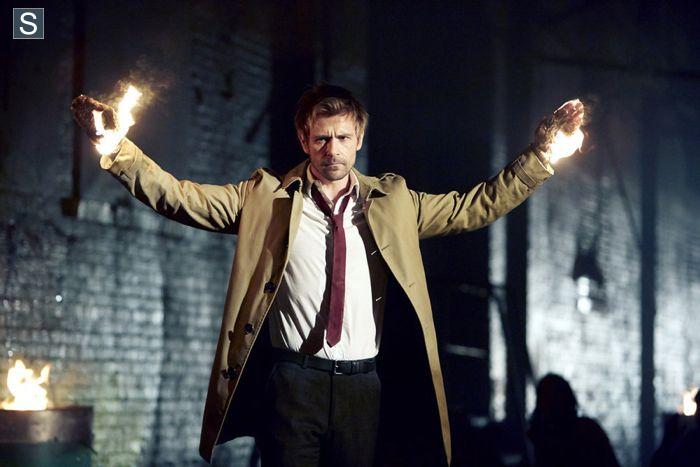
When people talk about saving John Constantine, usually it’s a hopeless task, as the scouser magician’s soul has long been consigned to hell for his many sins on earth. But another campaign to save Constantine is under way—and this time it’s fans attempting to keep his TV show going past a 13 episode commitment despite middling ratings.
Arrested Development has plans for a fifth season on Netflix, Twin Peaks will see you on Showtime twenty-five years from the 1991 series finale, and Yahoo Screen will bring Community closer to its promise of #sixseasonsandamovie, airing new episodes this spring. It’s a golden age of fan campaigns with the ability to resurrect dead and mostly-dead shows with measurably vocal fan bases. It’s a golden age fans of NBC’s Constantine are counting on, as the last of the series’ 13 episode initial run airs this Friday, February 13 at 10pm. The network has halted any further production on the show, prompting fans to organize on Twitter and Facebook under the hashtag #saveconstantine in support of its renewal — whether on NBC or another network entirely.
Fan campaigns to save television shows are nothing new, with the late sixties fan campaign to save the Star Trek original series largely credited as the first of its kind. Still, there does seem to be a trend in the growing power of fan campaigns to have an impact on programming, even those who represent much smaller audience shares than the high-profile efforts of yesteryear, prompting fledgling networks to pick up where network and even cable channels have left off.
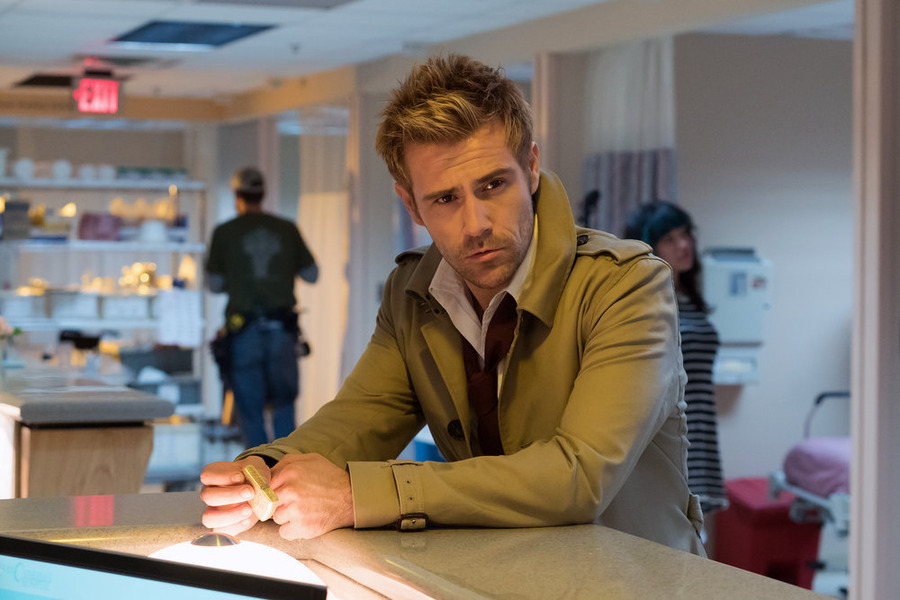
So what does all this mean for fans of Constantine, starring Matt Ryan as trench-coated demon hunter John Constantine? Do they feel a campaign to save the show, based on the long-running DC/Vertigo series Hellblazer, has a better chance of being saved now than it would have 10 years ago? “They definitely are more successful — especially with social networking being the way it is,” said Breanna Conklin, who has been active in the campaign to #saveconstatine since NBC confirmed in late November they would stop production on the series. “I am in a few nerd groups on facebook. You’re able to spread the word to like minded folks and your friends within a few seconds. Social media gives awareness that wasn’t available to us ten years ago.”
The #saveconstantine effort began to gain momentum when a slick-looking website, saveconstantine.com, went up in December. In addition to links to the petition and fan communities, saveconstantine.com offers a detailed description of the importance of the recently introduced Twitter TV ratings model from newly-formed group, Nielsen Social. An off-shoot of the more traditional Nielsen ratings, Nielsen Social “identifies, captures and analyzes conversation on Twitter in real time for every program aired across over 250 of the most popular U.S. television networks, including Spanish language networks, as well as over 1,500 brands” according to the company website.
The challenge for Constantine fans is to ensure that their awareness of the need to campaign for the continued life of the series is leveraged in a way that speaks both to NBC and their advertisers. It’s not enough to simply prove there’s interest in Constantine from the hallowed 18-49 age demographic; advertisers need to ensure that ad placements can actually have an impact on that demographic. As television consumption proliferates on an increasingly diverse group of content platforms, strong same-day viewing ratings don’t necessarily show advertisers that their ads will be seen instead of fast-forwarded on a DVR viewing post-broadcast.
It’s a challenge the organizers of the #saveconstantine effort hope to meet by being better educated on the increasingly complex world of network tv ad buys. “It’s a big group effort,” said Allison Gennaro, one of the campaigns many organizers. A fan of the Hellblazer comics, Gennaro became involved in the campaign upon hearing “NBC had capped the airing to just 13 [episodes],” which she took to mean the show was “in trouble” but also that the “ratings might not be meeting the NBC demo of choice.” Hoping to convince NBC not to cancel the series, the #saveconstantine organizers publicized a petition for the show to get a second season across social media platforms in late November. The petition cites a “38% bump in the ratings and an 87% viewer retention rating (after Grimm) with the introduction of The Spectre” as evidence of the viability of the series which currently boasts over 20,000 signatures.
The description on saveconstantine.com explains the impact live tweeting Constantine episodes can have on the Twitter TV ratings. The site believes the live tweets “denote that a show has a consistent and loyal audience,” and may show advertisers they “are being rewarded for their investment in the network…so if you want to save Constantine, please watch, tell your friends, and tweet.” Gennaro cultivated a group of Constantine fans through a mailing list to help push the #saveconstantine hashtag and live tweet campaign. “We even threw Friday night twitter parties before the show to trend and gain attention,” she said.
Fan campaigns of the past relied on letter writing, placing ads in trade magazines like Variety, even buying billboards to plead for their respective shows. While Constantine fans have also employed letter writing and email to NBC executives in this campaign, their informed approach in targeting advertisers and leveraging their consumer power is in step with more recently successful ‘save our show’ campaigns. In 2009, Wendy Farrington began a campaign to save another NBC series with supernatural overtones: Chuck. Her game-changing approach acknowledged the fact that the show enjoyed better ratings on off-network viewing platforms and galvanized fans of the series to support a major advertiser of the show, Subway.
According to a 2014 article by Christina Savage for Transformative Works and Cultures, which examined fan-run ‘save our show’ campaigns, on the day of Chuck’s season finale hundreds of fans went to their local Subway and bought a $5 foot-long sandwich featured on the series via product placement. They then left behind comment cards explaining their purchase was in support of Chuck. Savage explained that by “focusing on Chuck as a business transaction, fans used their knowledge of the industry” to support their effort. Shortly thereafter, NBC ordered 13 more episodes of the series. Savage wrote: “co-chairman of NBC Ben Silverman said that this campaign was one of the most creative he had seen, and as a result, Subway would increase its presence within the show.”
John Constantine may not eat at Subway, but fans of the demon exorcist are invoking similar brand marketing powers with their #saveconstantine efforts. Only this time, the fans themselves are the product. By targeting Nielsen’s Twitter TV ratings specifically, Constantine fans “become valuable social ambassadors for programmers and advertisers alike as they amplify content and messaging through their social spheres,” Nielsen Social wrote in a an article posted in September. But will it be enough to push NBC to order another season of Constantine? Could it make the show attractive enough to warrant a rumored move to sister-network Syfy, which has released several high-profile interviews with network executives seeking to return the channel to it’s Sci-fi/fantasy genre roots? NBC president Jennifer Salke told IGN in January that “we wish the show [Constantine] had done better live. It has a big viewership after [it airs] in all kinds of ways and it has a younger audience, but the live number is challenging.”
We spoke with Dr. Balaka Basu, a professor specializing in pop culture and fan studies at the University of North Carolina at Charlotte about the viability of the type of campaign #saveconstantine is waging. “Campaigns helped to save Chuck and Roswell, and gave Firefly fans closure in the less-than-successful Serenity,” she said. “ I think the key was demonstrating an understanding of how television economy works. With Chuck, for instance, fans literally gave their monetary support to the chain sandwich shop Subway…this demonstrates a comprehension of the relationship between advertisers and television producers.”
Fans like Miguel Gonzalez Cabañas, who lives in Madrid, show the global reach of the #saveconstantine fan efforts. He calls Constantine “the best series with a paranormal plot” on television. He, along with Allison, Breanna and the thousands of other fans who make up the campaign to #saveconstantine will be redoubling their efforts tonight: tweeting their support for the show before, during and after the season finale. But beyond the comic book fanbase, beyond charismatic lead Matt Ryan or the show’s arcane mythology: what is it about Constantine, or any other fan-campaigned series, that produces this kind of fan advocacy? “Whether it’s a show like Constantine, where many fans came into the show already in love with the character,” says Dr. Basu, “or shows like Buffy and Angel, where they were allowed to fall in love over the duration of the show, it’s really when the characters feel like real people that you don’t want your relationship with them to end, ever. And that’s been true since the days of Star Trek.”

By:
Heidi MacDonald,
on 1/29/2015
Blog:
PW -The Beat
(
Login to Add to MyJacketFlap)
JacketFlap tags:
review,
Reviews,
Comics,
DC,
Vertigo,
DC Comics,
Top News,
effigy,
tim seeley,
marley zarcone,
Add a tag
By Davey Nieves
EFFIGY #1
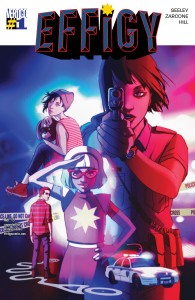
Story: Tim Seeley
Art: Marley Zarcone
Colors: Ryan Hill
Letters: Jared K. Fletcher
Publisher: Vertigo
Gloomy, hard-hitting, make no apologies stories have been the status quo for fans who pick up any Vertigo book. After all this is the line that gave us The Sandman, Y: The Last Man, and The Wake. Effigy by Tim Seeley (Hack/Slash)and Marley Zarcone may only get two out of the three, but this book is a rare occurrence where that’s actually what makes it a must read.
Writer Tim Seeley crafts a story about unhealthy obsessions that feels like it could only be told in this day in age given how many cautionary tales childhood actors have turned into. Effigy follows Chondra Jackson, a once bubbly star of a futuristic kids-as-cops series called Star Cops who after a downward spiral of typecasting and an ill-advised sex tape bottoms out into the life of a far less glamorous small-town cop. The night-and-day portrayal of Chondra captures her disconnect prom prominence exquisitely. This first issue doesn’t read so much as a behind the music type story, but more of a caution as to what the world around you can become when live most of your life in the clouds then have to deal with crashing towards reality. As she goes from being a glorified meter maid to a true detective we’ll see the high price of fame take it’s toll on those close to her and complete strangers who probably want to love her to death… literally.
Marley Zarcone’s art starts strong with so much energy in telling the back story of Star Cops. Then by design it settles into a more rural style. While not quite as energetic, it plays into creating a dichotomy of Chondra’s two lives. At first glance Ryan Hill’s colors seem like such a basic job, but when you see the panels containing more visual effects; it actually works in better highlighting these moments. The art does more than just add to Chondra’s already engaging story, it buttresses the –child-star to messed up adult– dark tunnel the audience is going to be taken through.
In a week where you couldn’t throw a rock without hitting a good comic, Effigy carves out a noticeable place for itself and on your pull list. Issue one sets up a world of glamour, ritual murder, and mystery that could lead to this series being one of Vertigo’s best 2015 books.
Dave has never been a child star but had a childhood crush on Winnie Cooper and Stephanie Tanner here more about it @bouncingsoul217

By:
Heidi MacDonald,
on 1/29/2015
Blog:
PW -The Beat
(
Login to Add to MyJacketFlap)
JacketFlap tags:
Top News,
effigy,
tim seeley,
marley zarcone,
review,
Reviews,
Comics,
DC,
Vertigo,
DC Comics,
Add a tag
By Davey Nieves
EFFIGY #1

Story: Tim Seeley
Art: Marley Zarcone
Colors: Ryan Hill
Letters: Jared K. Fletcher
Publisher: Vertigo
Gloomy, hard-hitting, make no apologies stories have been the status quo for fans who pick up any Vertigo book. After all this is the line that gave us The Sandman, Y: The Last Man, and The Wake. Effigy by Tim Seeley (Hack/Slash)and Marley Zarcone may only get two out of the three, but this book is a rare occurrence where that’s actually what makes it a must read.
Writer Tim Seeley crafts a story about unhealthy obsessions that feels like it could only be told in this day in age given how many cautionary tales childhood actors have turned into. Effigy follows Chondra Jackson, a once bubbly star of a futuristic kids-as-cops series called Star Cops who after a downward spiral of typecasting and an ill-advised sex tape bottoms out into the life of a far less glamorous small-town cop. The night-and-day portrayal of Chondra captures her disconnect prom prominence exquisitely. This first issue doesn’t read so much as a behind the music type story, but more of a caution as to what the world around you can become when live most of your life in the clouds then have to deal with crashing towards reality. As she goes from being a glorified meter maid to a true detective we’ll see the high price of fame take it’s toll on those close to her and complete strangers who probably want to love her to death… literally.
Marley Zarcone’s art starts strong with so much energy in telling the back story of Star Cops. Then by design it settles into a more rural style. While not quite as energetic, it plays into creating a dichotomy of Chondra’s two lives. At first glance Ryan Hill’s colors seem like such a basic job, but when you see the panels containing more visual effects; it actually works in better highlighting these moments. The art does more than just add to Chondra’s already engaging story, it buttresses the –child-star to messed up adult– dark tunnel the audience is going to be taken through.
In a week where you couldn’t throw a rock without hitting a good comic, Effigy carves out a noticeable place for itself and on your pull list. Issue one sets up a world of glamour, ritual murder, and mystery that could lead to this series being one of Vertigo’s best 2015 books.
Dave has never been a child star but had a childhood crush on Winnie Cooper and Stephanie Tanner here more about it @bouncingsoul217

By:
Heidi MacDonald,
on 1/15/2015
Blog:
PW -The Beat
(
Login to Add to MyJacketFlap)
JacketFlap tags:
telltale games,
A Wolf Among Us,
Reviews,
Comics,
DC,
Video Games,
Breaking News,
Fables,
Vertigo,
Top News,
Add a tag
by Edie Nugent
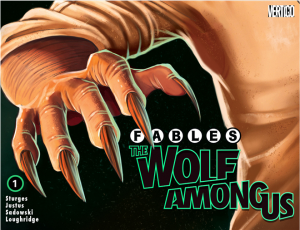 Writers: Dave Justus, Matthew Sturges
Writers: Dave Justus, Matthew Sturges
Artists: Steve Sadowski, Shawn McManus, Travis Moore
Colorist: Lee Loughridge
Letterer: Sal Sipriano
Cover Artist: Chrissie Zullo
Editor: Rowena Yow
Publisher: Vertigo
It seems fitting that Fables: The Wolf Among Us is Vertigo’s “first ever digital-first series” according to the publisher’s website. If you can parse that distinction, meaning Vertigo has never before released a comic series in digital format prior to it’s print debut, it makes a strange sort of sense that they chose this particular series to hold the title of first-ever first digital. Fables: The Wolf Among Us #1 is a comic series based on the popular Telltale video game series of the same name, which was itself based on the 14-time Eisner award winning series from creator Bill Willingham. While the digital version of Fables: The Wolf Among Us launched in early December 2o14 and is set to release “chapter 6″ of the ongoing story today, print-format fans get a good opportunity to catch up to digital readers with Fables: The Wolf Among Us #1 as it collects the first three chapters of the digital story in this first print issue.
The comic runs very close to the story, dialogue and plot of the Telltale game while also providing additional back story and details for a more in-depth story than the game provides. Having played the first installment of the game and now read this series, I found the first three chapters to be an enjoyable read. It was a solid decision to enlist Matthew Sturges in translating the video game story to comic form, his previous work on the Fables comic series that birthed the game that served as template for the comic (is your head spinning yet?) comes through in the additional material added to chapter 1. Sturges is aided by newcomer Dave Justus in the writing department and their collaboration is seamless: all the writing seems of a piece.
The decision to set the series as a prequel to the events in the original run of Fables was a good one: it is an easily understood entry point for new readers while also rewarding faithful fans of the aforementioned comic series, which began in 2002. The concept is simple: the fairy tale characters we all know have been chased out of their Homeland by a malevolent force. They’ve escaped to our world, setting up a new home in colonial America which later becomes New York City. Some are of means and can purchase glamours to hide their non-human appearance when applicable, others cannot.
We get to see Bigby Wolf (the second “b” stands for bad) as the newly minted Sheriff of Fabletown, as he responds to a domestic violence call from Mr. Toad (Wind in the Willows fans might be a bit shocked by his language) who reports a disruption in his upstairs neighbor’s apartment. Bigby is understandably not eager to take the call, as Toad’s upstairs neighbor is The Woodsman and their last confrontation of fairy tale legend didn’t end well for Bigby . The Woodsman proves he is still the brute with an ax he was back in the Homeland, beating up a mysterious woman called Faith who has resorted to prostitution to make ends meet in our mundane world. Bigby’s efforts to subdue him, however, only serve to escalate the violence.
Faith proves to be pretty lethal herself, dispatching the Woodsman handily just as he gains the advantage in his fight with Bigby. Faith is unruffled by the proceedings, taking her injuries and unpaid work for the Woodsman in stride. Bigby takes pity on her situation, and gives her what little money he has on him to help cover the debt. He also arranges to meet up with her later to get a statement detailing her abuse after she has returned to her boss with Bigby’s cash. Of course, any character that essentially says “I’ll be right back” is in narrative danger. Charmingly, when Bigby returns to his apartment to decompress, we run into another of the Sheriff’s former enemies: one of the three little pigs is crashed out on Bigby’s couch. This pig, known as Colin, demands whiskey and chain smokes while chastising the Sheriff for his lone-wolf habits. Also featured are some of Bigby’s earliest interactions with Snow White and Beauty (who is hiding from her Beast for unknown reasons).
The art across all the issues is different enough to showcase the style of the three artists: Steve Sadowski (chapter. 1), Shawn McManus (Chapter. 2), and Travis Moore (Chapter. 3), but also cohesive enough to provide a nice continuity of design. The series will hopefully go on to introduce more of the iconic Fables characters, while also making good on the answer to the compelling mystery set out in these first three chapters of the series.

By:
Heidi MacDonald,
on 12/30/2014
Blog:
PW -The Beat
(
Login to Add to MyJacketFlap)
JacketFlap tags:
david goyer,
Daniel Cerone,
Television,
Breaking News,
Constantine,
Vertigo,
NBC,
Showbiz,
DC Comics,
Top News,
Add a tag

Photo: NBC
When NBC’s take on DC/Vertigo’s chain-smoking anti-hero struggled in the ratings, the network halted production on Constantine after 13 episodes. Middling critical response and a terrible time-slot (Friday nights at 10 pm) didn’t help its cause, and the question became when/if NBC would ever air those remaining episodes after its mid-season finale capped out at the 8th episode.
Fans of the series took to social media with the #SaveConstantine hashtag, trying to stave off what seemed like the inevitable cancellation of the new series. Even executive producer Daniel Cerone got in on the grassroots action.
If nothing else, NBC has provided a stay of execution today, as the show’s official Twitter feed has announced Constantine‘s return on January 16th at 8 pm, where the 5 remaining episodes will air.
Will a new time-slot provide a shot in the arm or will it just be a fulfilling of an obligation? Time and viewership will tell.
By David Nieves
Last month Marvel announced former WWE Superstar, and upcoming UFC fighter, CM Punk would contribute a ten page story to February’s Thor Annual. Today on Vertigo’s blog, the publisher announced a new book for debut this Spring that will also feature a story written by Punk. Strange Sports Stories #1 is set for March release and will see the former wrestler join a list of talented creators such as Paul Pope, Gilbert Hernandez, Lauren Beukes, Ben McCool, Ivan Brandon, Monica Gallagher, Lee Loughridge, Nick Dragotta, Christopher Mitten, Darick Robertson, Mark Finn, John Lucas, Gabe Soria, Ronald Wimberly, Michael DiMotta, Tim Fish, Rael Lyra, and Brian Azzarello.
Strange Sports Stories shares a name with a six-issue DC Comics series that ran from 1973 to 1974. In 2015, Vertigo will release four chapters of the new series. No word yet on plot details or what issue Punk’s story will be featured in. However the series general theme seems to be, “strange, sexy, scary and extraordinary sports stories.” If any athlete in the last decade has experience with that it’s CM Punk. Only the first piece of art from the book was shown for solicitation today.
With his upcoming multi-fight UFC deal happening in 2015, CM Punk’s writing gigs could prove to be a great way for the comic book industry to get new eyes on the medium. Strange Sports Stories #1 is set to hit stores on March 18, 2015.
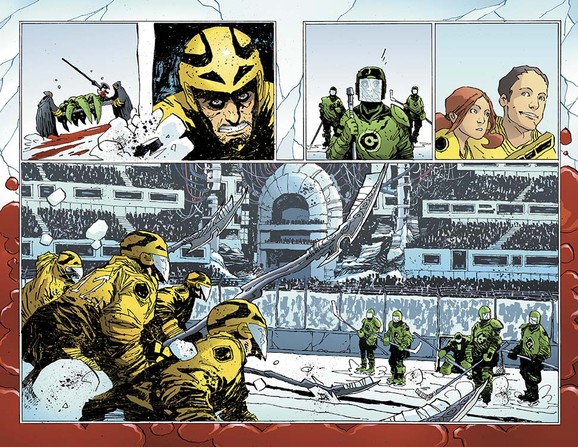

By:
Heidi MacDonald,
on 10/24/2014
Blog:
PW -The Beat
(
Login to Add to MyJacketFlap)
JacketFlap tags:
abraham reisman,
constantine pilot,
jamie delano,
Television,
DC,
Constantine,
Vertigo,
Top News,
Hellblazer,
matt ryan,
Add a tag
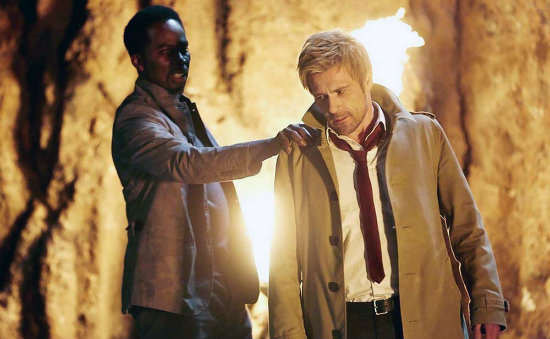
Yes, tonight is the night—the third of DC’s fall TV shows debuts on NBC at 10 pm EDT, Constantine starring Matt Ryan as the man, Harold Perrineau as Manny the angel, Charles Halford as best bud Chas, and in the pilot, Lucy Griffiths as the companion, Liv. This role is changed in future episodes to Angelica Celaya as Zed. (In a few stills, Liv bears a striking resemblance to Liz from Garth Marenghi, so perhaps this was for the best.) Also on board eventually, Jeremy Davies, Joey Phillips as Nergal, Miles Anderson as Dr. Roger Huntoon, Michael James Shaw as Papa Midnite. and Emmett Scanlan as Detective Jim Corrigan, who may become the Spectre if pasty white legs become a thing.
The show is brought to you by DC expert David S. Goyer and Daniel Cerone whose credits include Charmed, The Mentalist and the first few (good) seasons of Dexter. Cerone is a DC fan and claims that there will be something of the feel of Dexter, which would be okay if it’s the GOOD Dexter.
I’ve had the rough cut of the pilot kicking around for a while but haven’t wached it…I’m told what airs is quite a bit different so I’m happy seeing it with those of you who stay home on Friday night.
If you want to know more about Constantine and his comics history—and I do mean more— Abraham Reisman has written a near definitive guide, with quotes from Karen Berger, Peter Milligan, and even the guy who made Constantine Hellblazer, Jamie Delano, who wrote the first 44 issues of wha would become the Vertigo flagship.
Readers were enchanted. “There was a great buzz about Constantine,” Berger said, recalling the letters she’d receive from fans. “Alan very deftly planned him as this character who kind of drifted in and drifted out, leaving clues for something ominous and impending.” Which is, of course, the core of what keeps readers of superhero comics coming back to any given series.
Nearly all the subsequent Constantine writers I spoke to remembered how those Swamp Thing issues gripped them — especially because he gave so little away about his origins or what he knew. “You know that quotation from Moby-Dick, ‘It is the easiest thing in the world for a man to look as if he had a great secret in him’?” writer Mike Carey said. “That’s how Constantine was in Swamp Thing.”
Flavorwire offers five Hellblazer stories to read before the show, and they’re the ones you’d expect—Delano, Gaiman, Ennis, Azzaello, but a nice shout out to the Mike Carey standalone graphic novel.
Hellblazer ran for 300 issues and it’s definitely one of the great horror comics, even given the uneven nature of the various runs. Whiel the TV show is poised to put it more into the popular culture, or sink into oblivion, nothing will change my view of the comics, yadda yadda. I’m trepidatious over how “network” TV will treat this subversive character but is there even such a thing as network TV any more? And comcis have held their own as a culural force now. Let’s face it, you could NEVER EVER get away with casting Keanu Reeves as Constantine any more, and I guess that’s progress of a sort. Reviews have been middling, but it’s only the first episode.
I’ve rounded up some stills from the show, but before we get into that…here’s a few of the classic comic images, four by Glenn Fabry’s whose cover run was phenomenal and one by Leonardo Manco.
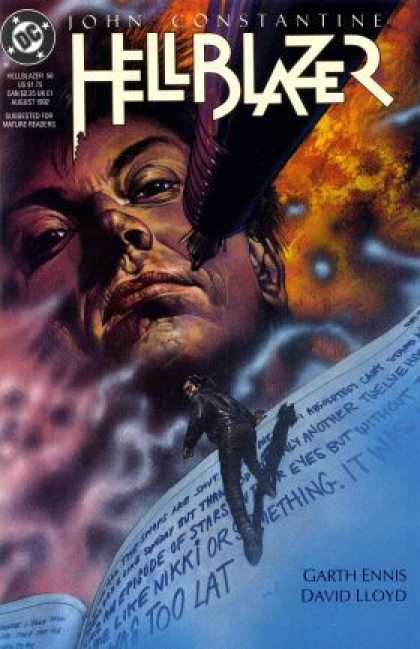
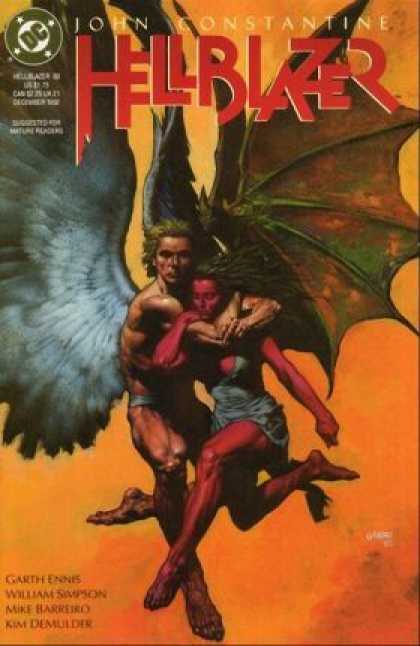
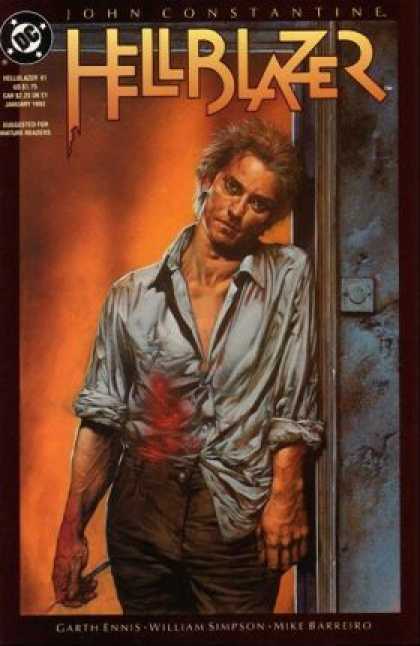
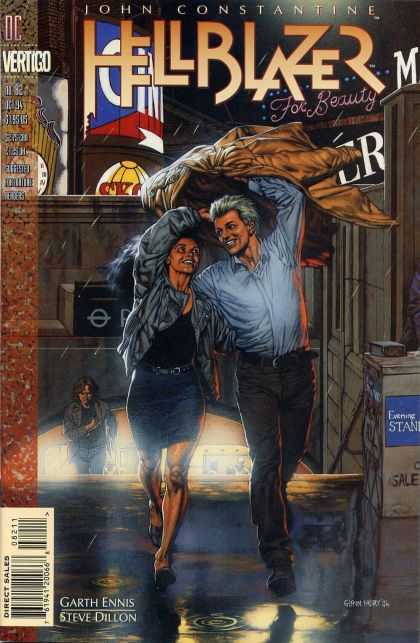

And the new version:
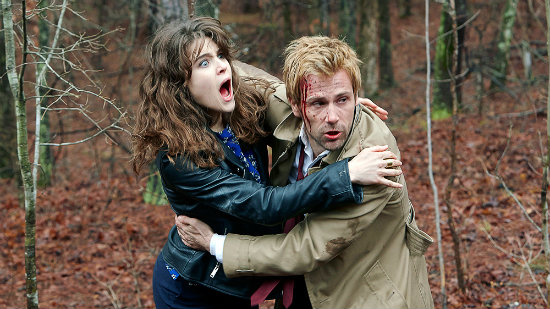
liv goes liz

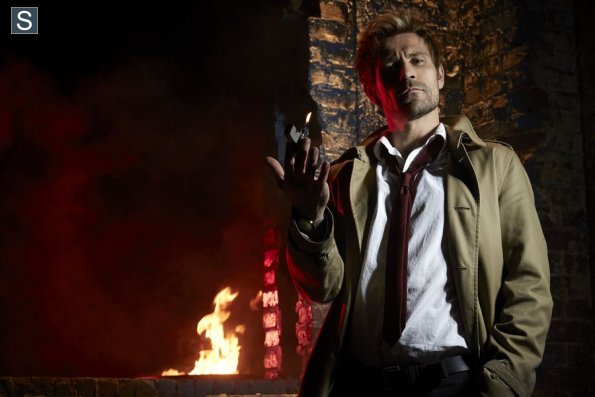
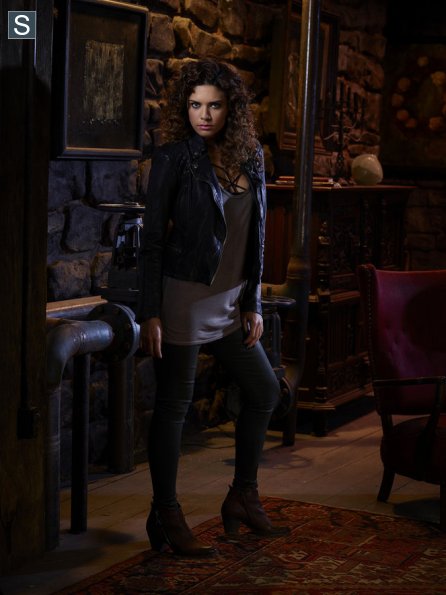
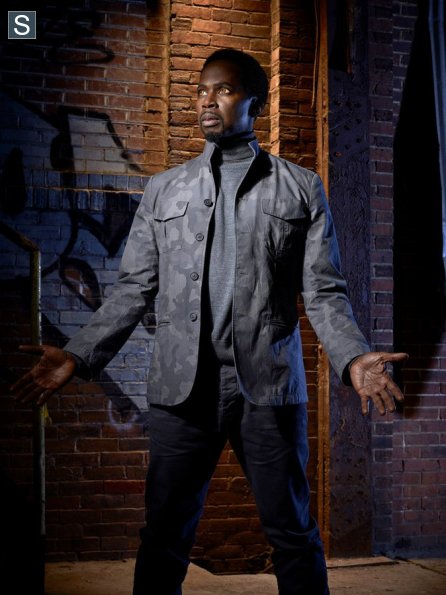

By: Charley,
on 8/8/2014
Blog:
OUPblog
(
Login to Add to MyJacketFlap)
JacketFlap tags:
measure angular,
accelerations,
semicircular,
Books,
Vertigo,
dizziness,
*Featured,
Science & Medicine,
Health & Medicine,
nystagmus,
medical publishing,
Bela Buki,
Benign paroxysmal positional vertigo,
BPPV,
Dix-Hallpike Maneuver,
jerking eye movements,
otoconia,
Vertigo and Dizziness,
exhibit nystagmus,
cupula,
Add a tag
By Béla Büki
Benign paroxysmal positional vertigo (BPPV) is a very frequent cause of harmless but unpleasant vertigo and dizziness complaints. It is caused by dislodged otoconia floating into the semicircular canals, which measure angular accelerations of the head and initiate corrective eye movements during fast head movements. Otoconia are calcium-carbonate crystals functioning as weights in the miniature acceleration sensors in the inner ear, informing us about gravity and linear accelerations. If they fall into the canals, their erratic movements produce false information of angular accelerations when the head position is changed, and then we feel dizziness.
Currently, the diagnosis of BPPV depends on the presentation of jerking eye movements (nystagmus) in the provoking positions, for example head-hanging. Nystagmus is elicited when the fluid in the semicircular canal deflects the sensory cells by deforming the cupula, a soft diaphragm at one end of the canals. During the routine clinical examination of BPPV, the patient’s head is brought into hanging position (the “Dix-Hallpike maneuver”). Should there be any otoconia in the canal, this allows them and their movements to be registered by observing the elicited eye movements.

Last year, I tried to design a table about BPPV and its different forms when different semicircular canals are involved. Filling in the table, I noticed that a form that was probably very frequent had not been satisfactorily examined and explained in literature. I wondered what happens when otoconia dislodge but do not fall into the one of the semicircular canals. This might be a frequent scenario, if, for example, the patient is upright or the dislodged debris misses the canal openings. The debris should sink to the most inferior part, which is, by chance, the cupula, the structure housing the sensory cells of one of the canals, the inferior canal. The deflection of the cupula informs the nervous system about fluid movements in the canal, thereby measuring angular accelerations. When the otoconia fall into this space and attach themselves to the cupula, thereby loading it and causing chronic, unpleasant dizziness with every head movement, they, in fact should not cause any nystagmus when the patient is moved from sitting into the head hanging position. This is because the head hanging position does not change the position of the cupula at all.
I realized that I discovered a possible mechanism for a frequent type of BPPV, with typical positional complaints but without nystagmus. This variant, although frequently encountered, has not been acknowledged so far. In theory it should be frequent, because, when dislodged in upright position (not in sleep but during daily activities), the otoconia should sink into the most inferior part of the vestibulum (which are the sensory cells of the inferior canal). This concept has been mentioned (but not explained) in literature. In a recent paper, for instance, South Korean doctors wanted to recruit a hundred patients with a diagnosis of BPPV for a study about vitamin D. During selection, 84 patients who reported a typical history suggestive of BPPV but did not exhibit nystagmus were excluded. This would mean that in the paper, 40% of patients with typical BPPV symptoms may have had complaints elicited by the mechanism described above. Currently, according to the classical criteria, in these cases, no diagnosis was possible.
Since I had not previously matched the theory against the opinion of peer-reviewers, we included this theory in a chapter with a title “Controversial issues” that was published in Otology Neurotology, the journal of the American Otological Society.
When verified by other authors, these ideas will be accepted and it will be possible to make diagnosis in cases which seem to be mysterious today. Although not so dramatic as overt BPPV with nystagmus, the patients with slight, chronic BPPV complaints feel ill enough to see a doctor and these cases may be frequent, considering the how frequent BPPV is.
Béla Büki is an ENT-specialist at Krems County Hospital, Austria. He is co-author of Vertigo and Dizziness, and his special interests include otoacoustic emissions, electrocochleography, non-invasive intracranial pressure measurements and neurotology.
Subscribe to the OUPblog via email or RSS.
Subscribe to only health and medicine articles on the OUPblog via email or RSS.
Image: Vertigo 08018, by Nevit Dilmen. CC BY-SA 3.0. Public domain via Wikimedia Commons.
The post How medical publishing can drive research and care appeared first on OUPblog.


Vertigo is NOT DEAD. Although a lot of people thought DC’s edgy imprint would go the way of the dodo in a more cost conscious environment, this is one of several interesting project I’ve been hearing about coming up. I’m told there will be even more before San Diego. This mini series hit in November and has covers by Doyle and Cloonan. Storywise, it’s American Hustle by way of Mob Wives, with 70s style taking over.
NYC. THE SEVENTIES. DISCO. PUNK. BLACKOUTS. SUMMER OF SAM. YANKEES FEVER. TIMES SQUARE.
This is the world of THE KITCHEN, a new 8 issue mini-series announced by Vertigo today.
Written by newcomer Ollie Masters with art by illustrator Ming Doyle, THE KITCHEN follows a group of four mob wives who get a taste for crime when their husbands are jailed.
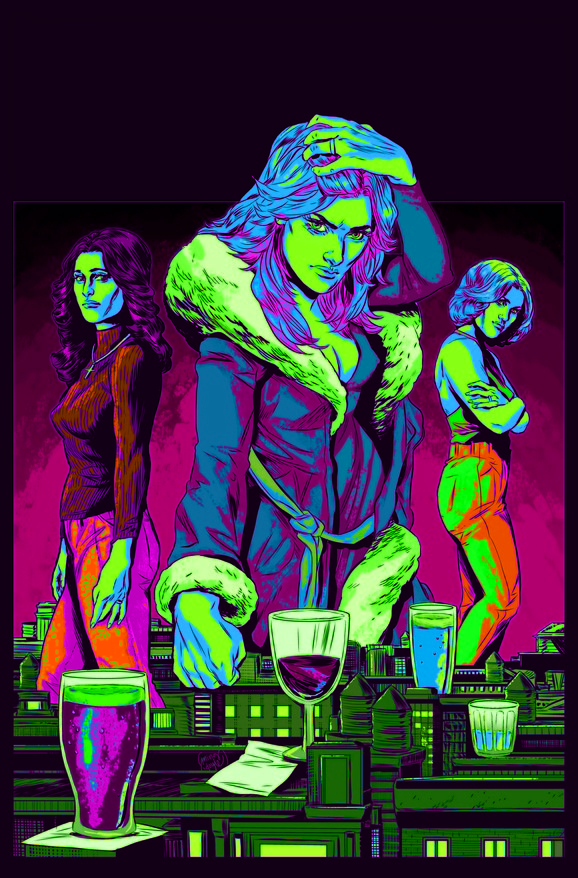




By:
Heidi MacDonald,
on 5/21/2014
Blog:
PW -The Beat
(
Login to Add to MyJacketFlap)
JacketFlap tags:
Andrew Dalhouse,
Sean Williams,
Steve Sadowski,
Interviews,
DC,
Bill Willingham,
Vertigo,
Top News,
Phil Jimenez,
Fairest,
Add a tag
Next week sees the release of the third trade of Fairest, the spinoff series of Fables which has seen a number of writers and artists tell standalone stories spotlighting the different female characters of Bill Willingham’s world. Return of the Maharaja, however, tries something a little different still – writer Sean E. Williams and artist Steve Sadowski introduce a new hero from myth to readers, in the form of Nalayani.
Coming straight from the epic mythology of Indian folkore, Nalayani is a dynamic, contrary, unpredictable sort of lead character; and her story dominates the third arc of the series. But Williams’ story not only brings in new characters like Nalayani – it also features some the return of some unexpected, familiar faces, to the shock of long-term Fables fans. I was lucky to have the chance to talk to Williams about his story, and he explained how it came together, the surprising twist appearance of a fan-favourite character… and giant monsters.
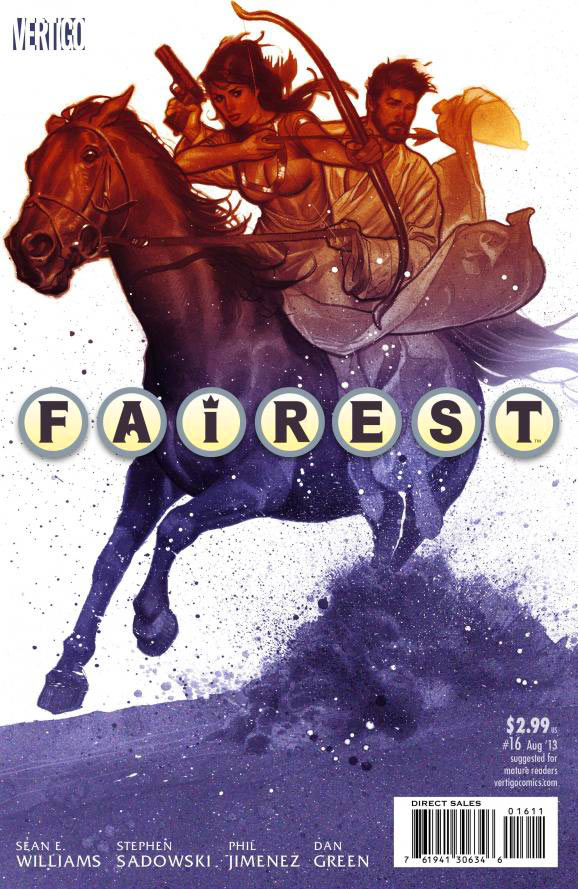
Steve: How did you get involved with writing this arc of Fairest?
Sean: I’d known Bill Willingham for years from working on another project together, and getting to be friends over the course of that time. Then Chris Roberson started doing the Cinderella arcs, and he was in the middle of the second one when I had an idea for a FABLES story that I just couldn’t get out of my head. So Saturday night of SDCC 2010 I was walking between hotels with Bill, and I got up the courage to ask him if he’d be interested in hearing a pitch for a story. He said he would be, so I immediately got away from downtown and wrote up a full proposal.
The next night, as we were setting up Bill’s dead-dog party, I pitched him the story. He said he liked it, and that they had something in the works that it might be a part of (which would become FAIREST; I think he was talking to Lauren Beukes about her arc already at that point).
Steve: Did you come with the pitch already in mind – what was your goal for the story?
Sean: Well, that’s where things get interesting. So yeah, I had a whole pitch fleshed out, and was bouncing it between Bill and our editor, Shelly Bond, getting feedback and notes and tweaking accordingly. Then I was in Minnesota that Christmas visiting the in-laws, and I drove down to visit with Bill. We went to lunch, and he got all serious, and said that he wanted me to write a Prince Charming story too. Which was great, but Charming’s dead, so it’d all be in flashback.
And who could say no to writing a FABLES Prince Charming story? Which (spoilers!) was when Bill dropped the bomb that Charming wasn’t dead. And my mind was blown. So I reaffirmed that I’d be interested, and ecstatically drove back to the in-laws. The next time I was able to get a hold of Bill was in March, I think, and I hadn’t heard anything, and I was starting to think the Charming thing was a practical joke, which Bill is known for.
I finally got a hold of him, and he told me it was a good news/bad news situation. Bad news was that I wasn’t writing my arc as planned. Good news was that Vertigo wanted the Charming story instead. I can say this now since it isn’t happening, but my original story focused on Bluebeard, and for some reason Prince Charming is more popular than Bluebeard. The only problem was that I hadn’t even thought about the Charming story, since I’d been working on Bluebeard for eight months. So in the span of weeks I had to come up with a whole story for Charming.
The only thing Bill gave me to start with was that Charming had been blown through the gateway, and I had to come up with why he hadn’t been back to Fabletown in the intervening years, and go from there.

Steve: The story is notably set outside of Fablestown, and the American-centric adventures around it. What research did you do to look into the role of Hinduism, and how important was it to you that you set the story in India?
Sean: In thinking about what type of Homeland Charming would be sent to, I threw out a bunch of non-Anglo options. Japan was the only one I had to stay away from, since Lauren was doing hers there, so the rest of the world was wide open. I’d been to India a couple of years before, and had enough of a cursory knowledge of Hinduism to know that there was an endless supply of stories to draw from, so I set my focus there. But unlike a lot of FABLES source material, Hinduism is a religion that’s very much alive today, and I wasn’t comfortable playing around with it willy-nilly.
I reached out to Dean Varun Soni at the University of Southern California (my alma mater) for his input, and (as a practicing Hindu), he walked me through what would be appropriate and what wouldn’t be, which really freed me up creatively. With that in mind, I dove into reading the epics, looking for characters who would be a good foil for Charming, and revisited Kipling’s stories, which play a huge part too, like Tabaqui, and the Village of the Dead.

Steve: Your lead character, Nalayani, comes from the stories of Hinduism. What about her made her click as a character for you – what drives the original version of her, and what drives your take on the character?
Sean: In her original story, which is told in the MAHABHARATA, she’s described as “one of the five ideal women,” so that checked the “fairest” box off the list. And what you have to remember is that there is no definitive version of these epics of Hinduism – who the good guy is in the RAMAYANA varies if you’re in the north or the south of India. So I read a couple of versions of her story, which all centered on how she was married to this leprous sage Maudgalya, and treated him well and tolerated him for years, and he revealed himself to be this paragon and they travelled the world for the rest of their lives enjoying “the five pleasures” (which also checked a box off the list, since it was Charming she’d be partnered up with).
But she was insatiable, and as punishment for her lust, a later incarnation of her has to marry five men. So the original story is basically “put up with your husband and you’ll be rewarded, but don’t be insatiable or you’ll be punished,” which isn’t exactly the story I wanted to tell, or thought that readers would enjoy. There’s some of that original story in the arc, – Maudgalya has a cameo, and the leprosy in particular plays a role – but I really dwelled on the idea of “where are the gods?” in the Indu, the Indian Homeland.
Well, of course the Indu was invaded by the Adversary, so that had some effect on the world, as we see, and I realized the gods were gone: this was an alternate universe from the Hinduism people know and practice, and that Nalayani and Maudgalya never married, which changed her whole story completely. She’s still a caregiver, though, so her whole focus in this arc is saving her village, which has been likewise devastated by the Adversary and all the fallout from the collapse of the Empire.
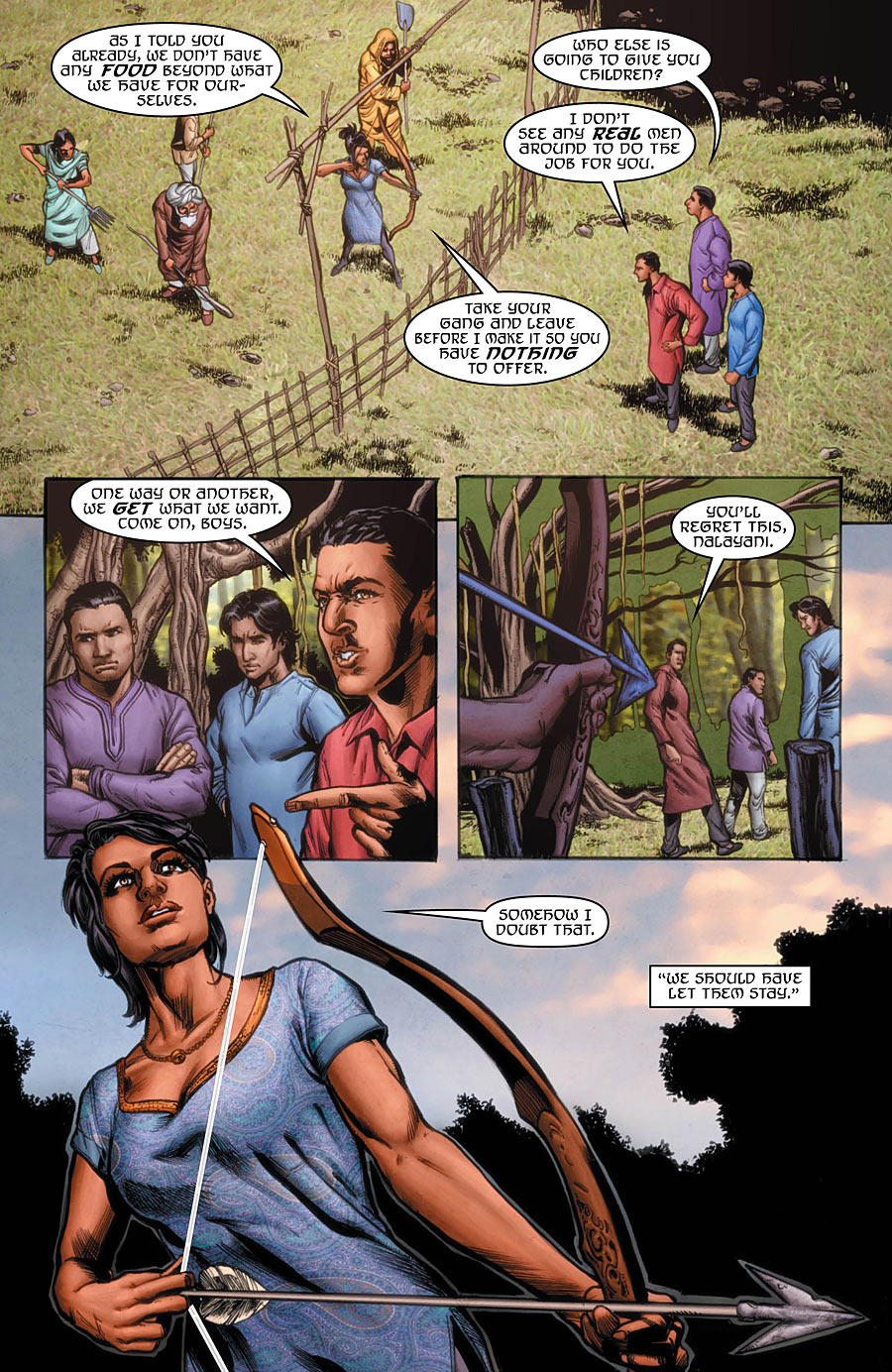
Steve: You got to work with the creative team of Steve Sadowski, Phil Jimenez and Andrew Dalhouse on the book – quite the team. What did they bring to the storyline, and how do you feel now looking back at the story as a whole?
Sean: As soon as I as saw the first pages Steve and Phil handed in, I knew we needed more animals and more wide shots. Steve’s animals KILL me, they’re so gorgeous. There’s a bit I wrote in the third issue that was supposed to be a throwaway beat, but Steve made the animal so alive that it became a crucial moment in the issue for me. Mugger Ghat (the giant crocodile, from THE JUNGLE BOOK) has a much bigger part because of these guys.
There are several monsters from Hinduism throughout the book that I basically transcribed their descriptions, having NO idea how something like that would look, but Steve blew them all out of the water, and made them believable to boot. He’s a genius. And all the textures and tone that Andrew brought to the clothing and the scenery…it’s a gorgeous book. We were really blessed to have these guys on board.
And, if I can add this, the fact that Todd Klein made a typeface based on Devanagari, the written form of Hindi, just for this arc still blows my mind to this day.
Shelly and Gregory Lockard were amazing editors to work with. Their instincts were spot on, of course, and they never talked down to me, even though this was my first published comic work (although Shelly did gently chide me at our first lunch when I made the rookie mistake of calling word balloons “word bubbles”). It’s just been humbling to work with the entire team, and I couldn’t be happier with the outcome. Hopefully the readers feel the same way!
-
Many thanks to Sean for his time! The third arc of Fairest, The Return of the Maharaja’, will be published by Vertigo next week. You can also find Sean online at his website here, and on twitter.
The first three minute look at Constantine, the upcoming NBC series based on the Hellblazer comics, has been released and there is good and there is bad.
I liked the callouts to actual comics, like the insect covered call of the very first issue, and the angel winged Mannym as played by Harold Perrineau. OBviously there were a lot of Glenn Fabry covers floating around on the set. THe story is set in NYC which I guess I can live with — filming in London would have been too expensive. The actual filming looks like Vancouver, but that’s typical.
I was only half convinced by Matt Ryan as Constantine. He looks the part but his line reading were as stiff as frozen maple syrup. And I know a Scouse accent would be unacceptable on American TV, but Ryan’s native Welsh accent came through most of the time. I guess most people expect him to sound like the Geiko Gecko (Cockney) but I’m sure this will grow on me.
The action looked Vancouver TV level, but faithful to the feel of the book. So rest assured when it debuts on Friday nights this fall I’ll be there to set my DVR!

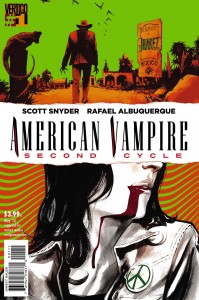 by David Fairbanks
by David Fairbanks
John Cunningham hosted C2E2′s Vertigo: Defy panel featuring Scott Snyder, Lee Bermejo, Greg Lockard, and Amy Chu.
Snyder is eager to return to American Vampire with Second Cycle, saying “Taking a break sucked. We had always planned to take a break because Rafael [Albuquerque] had stuff he wanted to finish, and I had the Superman stuff coming up, but we both immediately regretted it. It got me really depressed being away from the series.”
Second Cycle will focus on bringing together all of the characters and the various strains of vampirism and crashing them together. In the DC: All Access panel, Snyder described it as “every monster in the world versus the devil,” elaborating that he is exploring the idea behind why diverse and disconnected cultures have similar myths surrounding hell and the devil. Second Cycle will carry the series through 60′s and 70′s America with overlaps with the NASA space program, the Hell’s Angels, and borrowing elements from Spaghetti Westerns.
Bermejo describes Suiciders as a post-disaster book that takes place in a split LA 30 years after a massive earthquake, where the walled city of New Angeles shields the wealthy from the poor in Lost Angeles’ no-man’s land of crime and depravity. The title characters, the suiciders, are competitors in gladatorial games.
Lockard briefly mentioned Si Spencer’s sci-fi/horror/historical fiction mashup Bodies, which will see print in July and feature artwork from Dean Ormston, Phil Winslade, Meghan Hetrick, and Tula Lotay, each of whom will illustrate a different era in the career of a time-traveling serial killer.
The new anthology series CMYK takes the name from the four-color printing process of comics, with the first issue focusing on Cyan and carrying very loose connections to the theme. Cyan features nine stories, and Chu described hers as a conflict of new vs. old, focusing on a rebooted Detroit on the upswing with an older R&B singer who had been put out to pasture meeting up with an up-and-coming popstar at a ribbon cutting ceremony. Chu says “people didn’t know [she] could get that dark.” Fabio Moon will also have a six page overarching story in each of the CMYK books. Cyan is released April 30, with the remaining issues shipping quarterly.

By: Julia Callaway,
on 3/5/2014
Blog:
OUPblog
(
Login to Add to MyJacketFlap)
JacketFlap tags:
Vertigo,
oscars 2014,
wolf of wall street,
gravity,
academy awards,
Books,
*Featured,
TV & Film,
academy of motion picture arts and sciences,
Arts & Leisure,
12 Years a Slave,
Citizen Kane,
Add a tag
By James Tweedie
The annual Academy Awards ceremony draws weeks of media attention, hours of live television coverage beginning with stars strolling down the red carpet, and around 40 million viewers nationwide on Oscar night. The Academy of Motion Picture Arts and Sciences relegates the awards for technical achievement to a separate ceremony a couple of weeks before, a sedate affair in a hotel ballroom rather the spectacular setting of the Dolby Theater. While this division between the arts and sciences is clear in awards season, that boundary has almost disappeared in the movies themselves, as computer-generated imagery and digital 3-D now occupy a prominent position in most major studio productions.
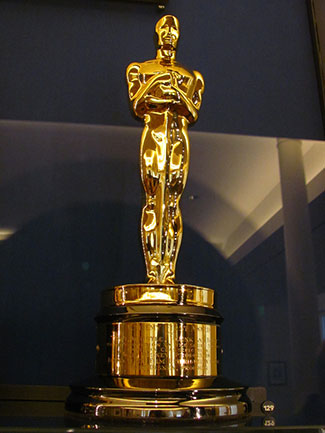
Academy Award for Toot, Whistle, Plunk and Boom at the Walt Disney Family Museum. Photo by Loren Javier. CC BY-ND 2.0 via Flickr.
For almost a century popular American cinema has been primarily a storytelling medium, with the motion picture sciences playing a more secondary role, but the distinction between the popular arts of Hollywood and the engineering of Silicon Valley is blurring. The movie business is being incorporated into a TED world where technology and design are the cornerstones of most big-budget entertainment.
For the first three hours of Sunday’s broadcast, Alfonso Cuarón’s Gravity seemed to be soaring toward a Best Picture Oscar, a victory that would have marked a new stage in this transformation of the American movie industry. A tour de force of technological innovation, Gravity won a total of seven Academy Awards, including the bellwether prizes for Best Editing and Best Director, and the voters appeared on the verge of bestowing their top honor on one of the first films to utilize the full potential of 3-D, a film that creates an almost visceral, stomach-dropping sensation of weightlessness as the camera and bodies appear to bob and drift through space. At other times the camera hurtles forward and the storyline rushes us from one space vehicle to another, propelled by an accidental explosion or the blast of a strategically deployed fire extinguisher. In those moments the weakness of Gravity is as unmistakable as its technical prowess: its virtuoso, gravity-defying feats are accompanied by an almost absurdly insubstantial and implausible plot, even by the standards of Hollywood, where happy endings have been arriving on cue for decades and most cars seem to have a magical sixth gear that allows them to fly over rising drawbridges. The narrative seems almost like an afterthought in Gravity, a pretext to link together one floating space platform and the next and to celebrate cinematic technology in itself, untethering it from earthly concerns like the plot.
But the Academy voters obviously had a different narrative in mind when they submitted their ballots, and in keeping with a long tradition of last-minute plot twists, they managed to compose a far more heartening conclusion to the year in film. In your average year, the Academy Awards are, to borrow the title of one of this year’s Best Picture contenders, an “American hustle.” Every March, we anticipate the canonization of a new Citizen Kane or Vertigo, half-forgetting that these films, among the most revered American movies ever made, won a grand total of one Oscar (Herman Mankiewicz and Orson Welles, for the screenplay for Citizen Kane). Kane was nominated in nine categories and lost eight of them, and Hitchcock and the other makers of Vertigo left the Pantages Theater empty-handed in 1959.
The list of regrettable Academy Award decisions and omissions (for example, Hitchcock’s career-long snub in the Best Director category or the single statuette given to Stanley Kubrick in his lifetime, for visual effects in 2001) is at least as long as Oscar’s triumphs. While viewers tune in for the glitz, glamor, comedy, fashion, and, on occasion, a genuinely moving acceptance speech (or a train wreck taking place at the podium), the ceremony also promises to provide an annual assessment of the state of American cinema. The opulent spectacle arrives each year without fail, but the Academy almost habitually overlooks the truly vibrant pictures and artists working in the film industry in the United States. What does Oscar reward instead?
The recipients of the major awards are usually not the most lucrative blockbusters (which have already received their rewards at the box office) nor are they the type of formally innovative and idiosyncratic pictures that enter the canon retrospectively. The films that tend to be overrated by the Academy are well-meaning films that appear to address an important social issue, while discovering some heroes and reasons for hope in an otherwise trying situation (Slumdog Millionaire, Crash, and Million Dollar Baby, to name three of the last eight Best Picture winners). Films by recognized American auteurs like Martin Scorsese, the Coen brothers, or Kathryn Bigelow have also fared well (see, for example, The Departed in 2006, No Country for Old Men in the following year, and The Hurt Locker in 2009), as have historical films that depict a triumph over hardship, with the formula for contemporary cinema—adversity, heroism, survival, and even a measure of vindication—retooled for use in the past. (See The King’s Speech in 2010 for the most recent example, but note also the run of five consecutive awards beginning in 1993 for Schindler’s List, Forrest Gump, Braveheart, The English Patient, and Titanic, which together established the historical film as a one of the surest paths to the podium.) What matters at Oscar time is the appearance of importance and a willingness to return to historical tragedies or to glance at contemporary social ills.
Viewed in retrospect, the Academy Awards perform something of a bait and switch, as instead of recognizing the best films created in the previous year they provide a barometer of the social and historical problems that continue to haunt us, including (to focus on this year’s nominees) political corruption, the excesses of Wall Street, uneven development, slavery and racism, the AIDS crisis, and the persistence of homophobia. This year’s Best Picture nominees have been justly scrutinized precisely because they seem so intimately linked with the problems they address. Four of the nine nominees are based on actual events drawn from the very recent past, another (Philomena) recounts a true story spanning a 50-year period from the middle of the twentieth century to the present, and 12 Years a Slave retells the autobiography of Solomon Northup, a free African-American from New York who was kidnapped and sold into bondage in Louisiana. Add Gravity to this strong group of films, and oddsmakers were predicting the tightest contest in recent memory, with these many returns to history pitted against an immersive, high-tech cinematic experience of the future.
In The Wolf of Wall Street, Jordan Belfort, a real-life financial scam artist played by Leonardo DiCaprio, finds himself unable to drive home after an overdose of Quaaludes that leaves him prostrate on the front steps of his country club. Summoning all his strength, he manages to slither across the driveway, hoist himself into his gull-winged sports car, and steer through a series of obstacles unscathed. Or at least that’s how the events unfold the first time, in what appears to be Jordan’s experience of reality. Immediately after that sequence, we see the police arrive and Scorsese presents us with a revisionist version, with a wreckage of cars and signposts left flattened in his wake. Hollywood’s approach to the past often resembles the first, more delusional of these scenes, with the heroic figure emerging triumphant from history.
In 12 Years a Slave the historical devastation caused by slavery is more frightening because the damage is all pervasive, because nothing is left uncorrupted by the system that frames every interaction through the lens of property. Screenwriter John Ridley and director McQueen had the courage to let Solomon Northup’s story remain largely unchanged from the original autobiography and to frame the most searing images in the simplest, most direct way, as in the agonizingly long take where a near lynching unfolds almost in slow motion. And in the best tradition of classical Hollywood cinema, McQueen manages to combine a compelling narrative with a series of subtle character portraits, as Northup travels through a looking glass from his prior existence as an accomplished musician and family man in New York to what seems like an alternative universe, where survival depends on the stripping away of those markers of identity and humanity. Rather than present slavery as an incomprehensible evil from another time, the film also chronicles the everyday rationalizations that allow the master to accept depravity as a way of life and the foundation of an economic order.
In most years the Oscars ceremony performs a bait and switch, as we await the announcement of the year’s best films and hear the name of a soon-to-be-forgotten film. But the Academy Awards also remind us why we continue to care about movies and ascribe to them a social significance and power all out of proportion with the relatively modest ambitions of even the Best Picture nominees, let alone the more standard studio fare. The Oscars are an advertisement for the potential of cinema to engage with traumatic historical and contemporary realities, even if we usually have to look elsewhere for the films that address those issues in all of their complexity. 12 Years a Slave, one of the few masterpieces also to win the award for Best Picture, reminds us that sometimes those films can come straight from Hollywood.
James Tweedie is Associate Professor of Comparative Literature and a member of the Cinema Studies faculty at the University of Washington. He is the author of The Age of New Waves: Art Cinema and the Staging of Globalization.
Subscribe to the OUPblog via email or RSS.
Subscribe to only television and film articles on the OUPblog via email or RSS.
The post Steve McQueen’s low-tech triumph: Looking at this year’s Oscar winners appeared first on OUPblog.


By: Jerry Beck,
on 5/1/2013
Blog:
Cartoon Brew
(
Login to Add to MyJacketFlap)
JacketFlap tags:
Illustration,
Comics,
Vertigo,
Titmouse,
Artist of the Day,
Black Dynamite,
d-pi,
Prince of Cats,
Ronald Wimberly,
Add a tag

Ronald “d-pi” Wimberly is an artist who has worked in film, fashion, comics, and most recently, animation.
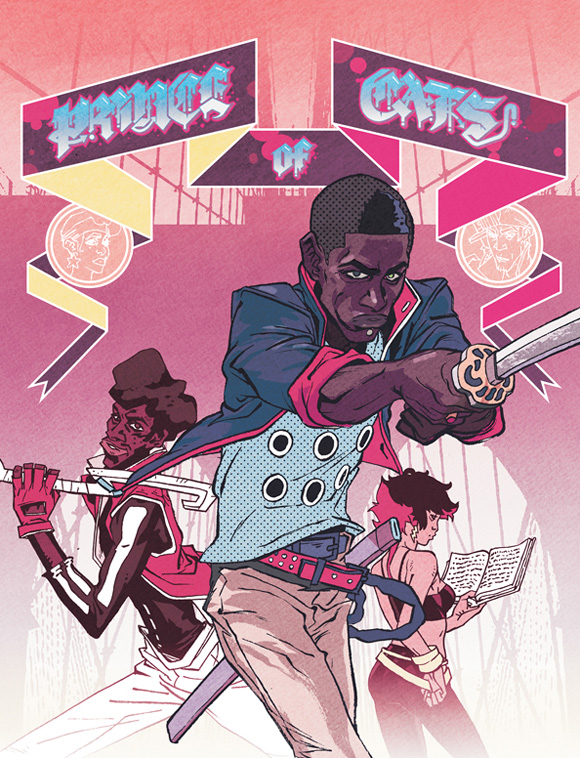
He is the author of the comic book Prince of Cats , which was published by Vertigo. As his foray into the animation production world, Ronald has been designing characters on Black Dynamite: The Animated Series for Titmouse.
, which was published by Vertigo. As his foray into the animation production world, Ronald has been designing characters on Black Dynamite: The Animated Series for Titmouse.
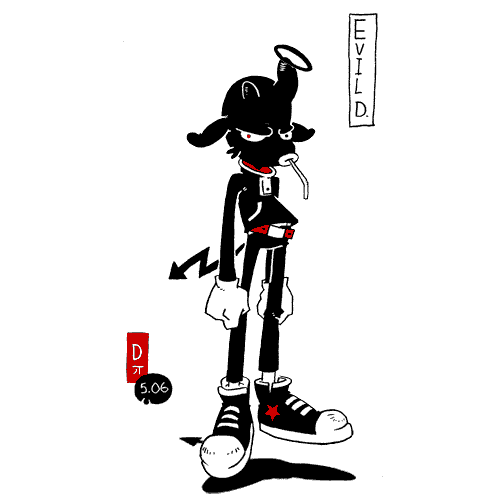
Ronald’s artwork often features figures in action, stretching and lunging through exaggerated space. He posts a lot of new work on his blog.
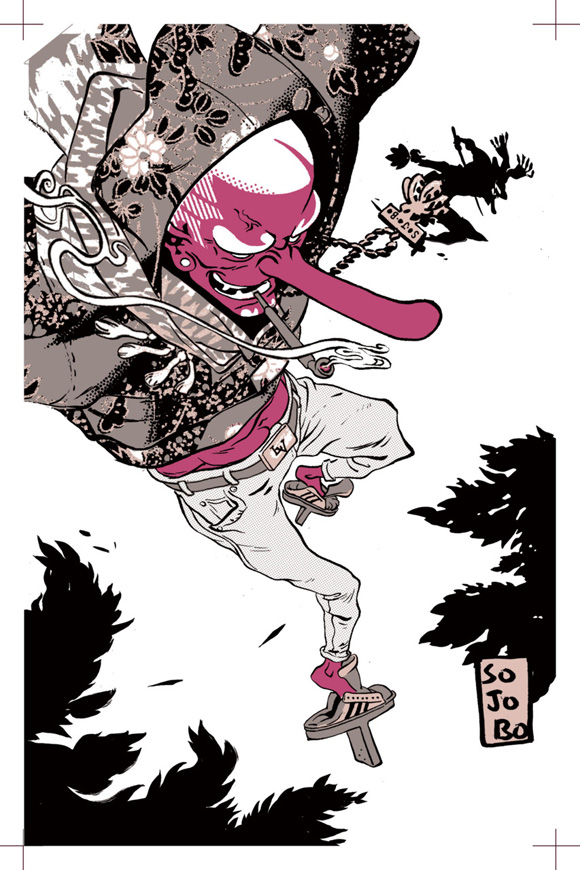
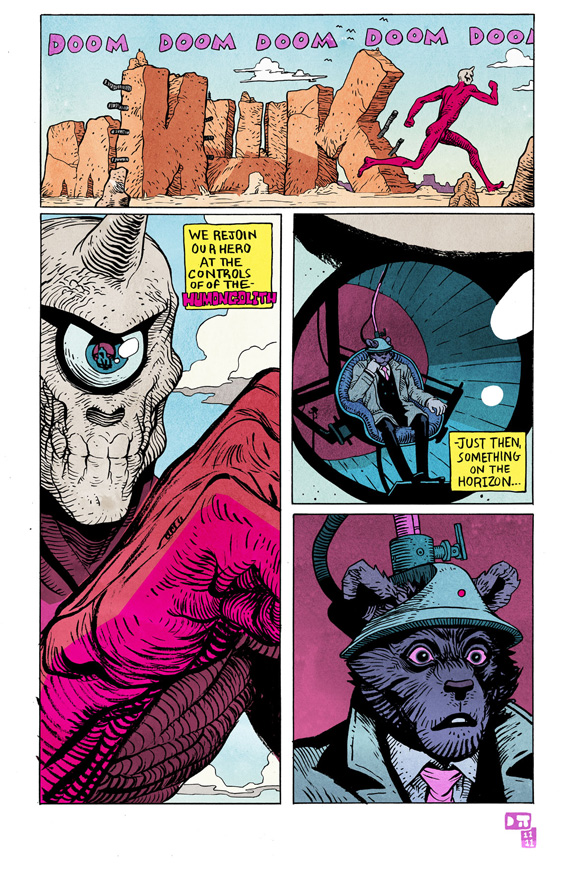

By:
Heidi MacDonald,
on 3/28/2013
Blog:
PW -The Beat
(
Login to Add to MyJacketFlap)
JacketFlap tags:
News,
science fiction,
Reviews,
Comics,
DC,
Todd Klein,
time travel,
Vertigo,
Jeff Lemire,
Dan Abnett,
DC Comics,
Mark Buckingham,
Jose Villarubia,
Gail Simone,
Tom Fowler,
Top News,
Ray Fawkes,
Simon Spurrier,
Peter Milligan,
Damon Lindelof,
Jordie Bellaire,
Andy MacDonald,
Dead Boy Detectives,
Gael Bertrand,
I.N.J. Culbard,
Lee Loughridge,
M.K. Perker,
Matt Kindt,
Michael Dowling,
Neil Gamain,
Time Warp,
Toby Litt,
Tom King,
Travis Lanham,
Victor Santos,
Add a tag
Publishers seem increasingly willing to roll the dice on anthology formats recently. Maybe it’s the success of things like Dark Horse Presents, and the model they’ve followed of introducing new works and then successfully spinning them off into new story titles like BLACK BEETLE. There’s an inherently approachable aspect to anthologies—new readers can pick them up and take a tour of many ideas and art styles without feeling out of the loop, and creators themselves aren’t subjected to the high-wire act of telling fresh tales while balancing the necessities of continuity. It’s also a chance to bring on new talent and give readers a chance to play a role in selecting what appeals to them. Vertigo, however, has a long history of valuing the anthology format to engage with new readers, from its FIRST CUT to FIRST OFFENSES, which readers still pick up when trying to get a handle on what the line has to offer in terms of genre and content.
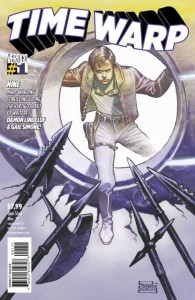 TIME WARP, a revival of a late 1970’s anthology format, presents nine stories by a variety of well known and new creators following a loose theme that may not be as loose as it appears at first glance. The key word “time” stands out as a recurring (literally) factor in these stories. On the whole, because the anthology contains so many varied story-telling techniques and art styles, its appealing and gives the reader a sense of time and money well spent based on its “something for everyone” approach. As a one-shot, it also reads like a graphic novel in disparate parts that comments on the potential of science fiction in the comics medium with capacity to challenge our concepts of humanity, technology, and their often troubled relationship.
TIME WARP, a revival of a late 1970’s anthology format, presents nine stories by a variety of well known and new creators following a loose theme that may not be as loose as it appears at first glance. The key word “time” stands out as a recurring (literally) factor in these stories. On the whole, because the anthology contains so many varied story-telling techniques and art styles, its appealing and gives the reader a sense of time and money well spent based on its “something for everyone” approach. As a one-shot, it also reads like a graphic novel in disparate parts that comments on the potential of science fiction in the comics medium with capacity to challenge our concepts of humanity, technology, and their often troubled relationship.
[Caution: Mild spoilers on content, but no plot-twist revelations ahead]
“R.I.P” , written by Damon Lindelof, with evocative art by Jeff Lemire and fluid colors by Jose Villarubia, is a strong start to the collection. What could be more basic, pulpy, and attractive than a time-travel tale with dinosaurs and multiple attempts to escape death? The story’s variations on a theme, however, get complex quickly, with satisfying results. All the kinds of questions about the implications of time travel that kids grew up with watching Star Trek: The Next Generation take a bite out of the story and lead the reader in logical loops. Lemire’s energetic, chaos-controlling line-work, combined with Travis Lanham’s quirky lettering, suggest an undercurrent of the haphazard about all human endeavors. The message seems to be, despite all our planning, when we deal with factors essentially bigger than us, we might get by, but only by the skin of our teeth. The suspension of belief necessary for the story isn’t overbearing since it points out all the problems and difficulties of handling big themes in its plot structure.
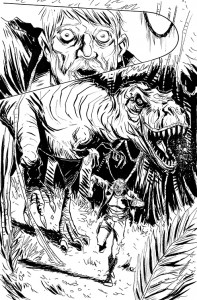 “It’s Full of Demons” is a particularly challenging story, one might almost call a mystery despite its early introduction of a possibly alien time traveller in turn of the century Austria. After reading the complete story, you might have a Memento-like experience of reconstructing the details of the story backward along the lines provided by a full revelation of their significance. This is engaging for the reader. Tom King’s writing is clever in providing just enough detail to make this backward reading possible while not revealing too much about why the increasing madness of a little girl growing up after her brother’s death might be important to readers. The themes of the story are, in fact, heavier the more you examine them, commenting on how fear and the “demonizing” of figures and groups may be an even greater threat than the shocking intrusion of the vastly unknown into daily life. Tom Fowler’s artwork suggests history well without rendering it ponderous, and in particular conveys emotional states in its main character with great empathy.
“It’s Full of Demons” is a particularly challenging story, one might almost call a mystery despite its early introduction of a possibly alien time traveller in turn of the century Austria. After reading the complete story, you might have a Memento-like experience of reconstructing the details of the story backward along the lines provided by a full revelation of their significance. This is engaging for the reader. Tom King’s writing is clever in providing just enough detail to make this backward reading possible while not revealing too much about why the increasing madness of a little girl growing up after her brother’s death might be important to readers. The themes of the story are, in fact, heavier the more you examine them, commenting on how fear and the “demonizing” of figures and groups may be an even greater threat than the shocking intrusion of the vastly unknown into daily life. Tom Fowler’s artwork suggests history well without rendering it ponderous, and in particular conveys emotional states in its main character with great empathy.
Gail Simone writes “I Have What You Need”, with upbeat and somewhat eerie art by Gael Bertrand, and vibrant colors by Jordie Bellaire. Simone isn’t afraid to get complicated, either, about the implications of time travel, even within one’s own mind, and delves pretty deeply into human nature by exploring the idea that a drug could enable you to revisit the best ten minutes of your life. Her kindly shopkeeper holds this god-like key to a “product” that everyone wants, and also provides commentary on what humans deserve, and what they get out of life. Twist endings are a common feature of many of the stories in TIME WARP, and though the stories might have been intriguing without them, it’s a pattern that gives the reader a sense of the value of each particular story as a unit of entertainment and harks back to the genre features of early pulp sci-fi.
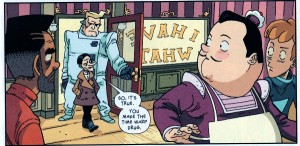
“The Grudge” is an intelligent and very human tale of rivalry between two scientists, the kind of rivalry we’ve seen in techno pop culture between Steve Jobs and Bill Gates. Written by Simon Spurrier, with art and color by Michael Dowling, its compressed storytelling gives you a sense of having read a whole comic or perhaps a graphic novel, again presenting an entirely different, detailed world within the anthology. It spans the life of these scientists, their tragedies, and the tension between public demand for spectacle in scientific discoveries and the real needs of scientific advancement to look toward greater future building. Dowling’s near photo-realistic art style easily conveys the sense that this could be our twenty-first century future, still governed by the baser, and higher impulses of the human beings involved in advancement. But the story infuses even tragedy with humor, and most importantly, believing in the reality of the characters helps convey the messages of the narrative.
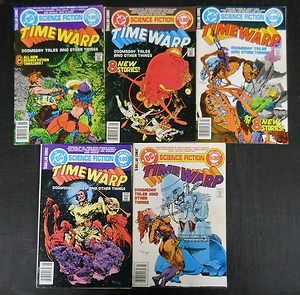 One of the most surprising additions to TIME WARP is a Dead Boy Detectives story. Originally created by Neil Gaiman as a spin-off from SANDMAN, the Dead Boy Detectives seem to veer pretty far from science fiction in their investigation of the occult. However, Gaiman was never one to draw a firm line between the occult and the scientific, and neither has pulp tradition, a borderland other comics in TIME WARP also explore. This episode, “Run Ragged”, written by Toby Litt, with layouts by Mark Buckingham, finishing work by Victor Santos, and letters by the great Todd Klein, reads like a sudden glimpse of a return to a favorite world, and indeed it’s described as a lead-up to a continuing storyline in THE WITCHING HOUR ANTHOLOGY. The artwork, and also the colors by Lee Loughridge are accomplished and appealing, particularly successful at conveying motion and action while creating a sense of the haunted atmosphere of the material.
One of the most surprising additions to TIME WARP is a Dead Boy Detectives story. Originally created by Neil Gaiman as a spin-off from SANDMAN, the Dead Boy Detectives seem to veer pretty far from science fiction in their investigation of the occult. However, Gaiman was never one to draw a firm line between the occult and the scientific, and neither has pulp tradition, a borderland other comics in TIME WARP also explore. This episode, “Run Ragged”, written by Toby Litt, with layouts by Mark Buckingham, finishing work by Victor Santos, and letters by the great Todd Klein, reads like a sudden glimpse of a return to a favorite world, and indeed it’s described as a lead-up to a continuing storyline in THE WITCHING HOUR ANTHOLOGY. The artwork, and also the colors by Lee Loughridge are accomplished and appealing, particularly successful at conveying motion and action while creating a sense of the haunted atmosphere of the material.
“She’s Not There” may remind readers of the more psychological aspects of good science fiction, with more than a dash of the noir emphasis on intense relationships. The premise, that a company in the future can charge vast amounts of money to resurrect ghosts as “information” gleaned from loved ones, hits one of the many common themes in TIME WARP, the general neediness of human beings and the lengths they’ll go to in order to seek comfort from their pasts. Another “mystery” aspect of the story, written by Peter Milligan, with art and colors by M.K. Perker, is the reason for the resurrected wife Angel’s death, and the lingering problems that might have comprised her relationship with her husband in the first place. The story poses a unique question, “Can you own a ghost?”. In a technological world where everything’s a commodity, it seems like a singularly dark possibility. The artwork suggests a blend of the familiar and the unknown in equal proportions, keeping readers guessing, just like the plot.
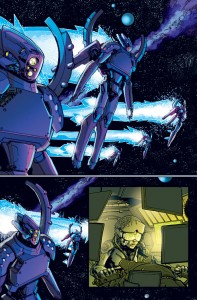 The unusually titled story “00:00:03” places human beings under another kind of microscope under the pressure of extreme situations. During vast interstellar wars, we follow the decisions of Helene as she attempts to perform her military duties under the influence of a unique “molasses” protocol that extends perception of time. Written by Ray Fawkes and drawn by Andy MacDonald, this is the kind of story that sci-fi readers will be particularly attracted to. It offers sweeping conflicts on a large stage, space battles, and remarkably deep characterization of a central figure in action. The age old question posed by sci-fi, “Are we still human inside our technology?”, is both addressed and answered in a poignant way.
The unusually titled story “00:00:03” places human beings under another kind of microscope under the pressure of extreme situations. During vast interstellar wars, we follow the decisions of Helene as she attempts to perform her military duties under the influence of a unique “molasses” protocol that extends perception of time. Written by Ray Fawkes and drawn by Andy MacDonald, this is the kind of story that sci-fi readers will be particularly attracted to. It offers sweeping conflicts on a large stage, space battles, and remarkably deep characterization of a central figure in action. The age old question posed by sci-fi, “Are we still human inside our technology?”, is both addressed and answered in a poignant way.
If you’re all about the art of sci-fi comics, then you’ll have quite a few surprises to look forward to in TIME WARP, but it’s likely that Matt Kindt’s “Warning: Danger” will be top of the list. With Kindt’s sketchy outlines, and splashy use of watercolor tones, the story breaks from many of the common assumptions of what traditional sci-fi art should look like. How do you convey the crisp lines of spectacular technology in such an idiosyncratic style? Kindt’s answer is to render technology, and its premises in the story, organic, and therefore a little more alarming. By breaking with what readers may recognize, Kindt presents an unrecognizable, and very compelling vision of the future. His diagrams of the armor and accoutrements of two civilization-representing soldiers locked in single combat schematize the ingenuity and determination of one-upmanship in 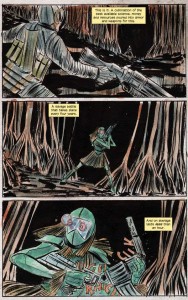 technological advancement. There’s a downbeat sense of recurring time that’s featured in a number of TIME WARP stories, providing the opportunity for humans to relive their obsessions and failures, or get it right when given another chance.
technological advancement. There’s a downbeat sense of recurring time that’s featured in a number of TIME WARP stories, providing the opportunity for humans to relive their obsessions and failures, or get it right when given another chance.
The final piece in TIME WARP gathers together the thematic threads of recurring time, human decision-making, and the bizarre responsibilities that power over technology entails. When technology becomes somewhat monstrous, who’s really in control? Is the humanity inside the machine enough to guide progress away from disaster? “The Principle” is written with a key focus on two main characters by Dan Abnett, and presented rather beautifully with colors and art by I.N.J. Culbard. The trope of presenting a guy new to his job as an identifying character for the readers is here completely necessary to add tension to the gradual revelation of plot. The attempt to prevent an assassination of the “principle” figure through staging the same moment in time over and over again gives characters repeated chances to get things right, and also humorously comments on some historical mysteries as time-travel screw ups. Culbard’s inks, particularly, have a certain noir sensibility, too, though infused with a sci-fi eye toward motion, and seem appropriate when grounding the future in the past. Abnett doesn’t hold off on the sci-fi theme of responsibility, either, and closes the collection with a final message about the tendencies of 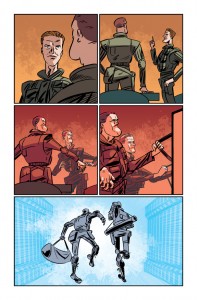 humanity to abuse power in banal ways, and the responsibilities, often dire, we face in trying to keep that kind of potential chaos under control.
humanity to abuse power in banal ways, and the responsibilities, often dire, we face in trying to keep that kind of potential chaos under control.
In fact, looking back through TIME WARP, the overarching implication of these stories seems to be Time=Responsibility. The further we push technological advancement, and the more we tinker with our humanity, the more work we generate for ourselves monitoring our trajectory. But with concepts and artwork like the kind contained in TIME WARP, the spectacle of those sci-fi heights never ceases to be attractive, even when it’s pointing out the potential pitfalls that almost certainly lie ahead. TIME WARP contains a miscellany of energetic science fiction, and its hard not to find the sheer breadth of material and the talent behind it a selling point. Nine worlds, and compact story-telling that often spans lifetimes in one volume? It’s both entertaining and consistently thought-provoking, marking a worthy return of the TIME WARP title.
Title: TIME WARP #1/Publisher: Vertigo, DC Comics/Creative Teams:
“R.I.P”: Damon Lindelof, writer, Jeff Lemire, artist/“It’s Full of Demons”: Tom King, writer, Tom Fowler, artist/“I Have What You Need”: Gail Simone, writer, Gael Bertrand, artist/“The Grudge”: Simon Spurrier, writer, Michael Dowling, artists/“Dead Boy Detectives”: Toby Litt, writer, Mark Buckingham, layouts, Victor Santos, finishing/“She’s Not There”: Peter Milligan, writer, M.K. Perker, artist/“00:00:03”: Ray Fawkes, writer, Andy MacDonald, artist/“Warning: Danger”: Matt Kindt, story and art/“The Principle”: Dan Abnett, writer, I.N.J. Culbard, colors and art
Hannah Means-Shannon writes and blogs about comics for TRIP CITY and Sequart.org and is currently working on books about Neil Gaiman and Alan Moore for Sequart. She is @hannahmenzies on Twitter and hannahmenziesblog on WordPress.

By:
Heidi MacDonald,
on 3/24/2013
Blog:
PW -The Beat
(
Login to Add to MyJacketFlap)
JacketFlap tags:
News,
DC,
Fables,
Bill Willingham,
Top News,
fables con,
Conventions,
Vertigo,
Shelly Bond,
Add a tag
by Matt O’Keefe
It was a packed room at the show’s official panel for the comic for which the convention was named. Bill Willingham, Mark Buckingham, Shelly Bond and company began the event giving out prizes to winners of the con scavenger hunt. The grand prize winners, a couple and their baby daughter, received first a song from Gene Ha, who sang “Blue Skies” to loud applause. Willingham then blindfolded the mother and challenged her to identify several objects by feel alone. Whatever she identified, she got to keep. She wasn’t able to guess the first item, the pen with which Willingham wrote Fables #47, or the second, the dollar editor Shelly Bond told Willingham his first draft of Fables #97 was worth. She successfully guessed the third object: an engagement ring. The father proposed in front of everyone and she accepted, to more applause.
<!–more–>
Next it was time for announcements. Willingham repeated the announcement from Emerald City Comic Con that Vertigo would publish a Fables Encyclopedia written by Jess Nevins with a cover by Adam Hughes. He went on to tell the crowd that they were working on a companion book for a 2014 release, which would have interviews with the Fables creators and background on the series.
Fables editor Shelly Bond then talked about the upcoming Fairest original graphic novel also announced at ECCC which, like the 1001 Nights of Snowfall OGN, will be an anthology with art by a variety of artists. She revealed that Fables regular Chrissie Zullo would provide the framing sequence and that other illustrators included Mark Chiarello, Karl Kerschl, Adam Hughes, Phil Noto, Renae de Liz, Chris Sprouse, and sometimes singer Gene Ha.
Bond went through a PowerPoint presentation to talk about issues of Fables coming up in the next few months. She highlighted three future covers. The first teased the return of Boy Blue, the second showed Snow White kissing someone other than her husband Bigby Wolf, and the third showed Snow as Joan of Arc. She talked about the issue after the “Snow White” arc, which will be illustrated by Barry Kitson. In the issue Junebug, the daughter of former wooden soldiers Rodney and June, would visit the abandoned Fabletown.
Willingham opened the floor to a Q&A.
Asked about his unique borders for the series, Buckingham talked about how in the third arc of Fables, once he knew that he was the ongoing artist, he began to get playful and designed the borders so readers would know which character’s stories they were reading.
Plans to bring back Jack? Willingham pointed out that his death in Jack of Fables happened at some undisclosed time in the future, so his return to the main Fables series was a possibility.
An attendee asked the panel which character from Fables they most identified with. Gene Ha said Flycatcher because he was someone who didn’t reach his full potential until later in his life. Willingham joked that he was like Bufkin because he drinks too often and has too many books. Bond chose Thumbelina so she could beat Willingham to the punch on a joke about her height. Buckingham said he was like Wellstoff because when drawing he tends to sit around all day eating jellybeans.
Does Bill Willingham always have a big picture in mind when writing? Yes. Willingham said he could do a three page comic and still conceive the whole world in which the story takes place. His default setting is to think big.
Would Bufkin’s solo adventure be in the next Fables trade paperback? Yes.
Asked about spontaneous changes, Willingham told the audience that he was going to kill off Flycatcher in the March of the Wooden Soldiers arc, but Buckingham convinced him to reconsider. Flycatcher went on to become a significant character in the series.

By:
Heidi MacDonald,
on 3/1/2013
Blog:
PW -The Beat
(
Login to Add to MyJacketFlap)
JacketFlap tags:
News,
Movies,
Reviews,
Comics,
DC,
Vertigo,
Movie Comics,
Stieg Larsson,
The Girl with the Dragon Tattoo,
Top News,
Denise Mina,
Andrea Mutti,
Giulia Brusco,
Leonardo Manco,
Patricia Mulvihill,
Steve Wands,
The Girl with the Dragon Tatoo Book 1,
The Girl with the Dragon Tattoo Book 2,
Add a tag
Vertigo released Book 1 of its THE GIRL WITH THE DRAGON TATTOO graphic novel adaptation of the award-winning posthumously published Millennium Series novels by Stieg Larsson in 2012 in hardback, begging the question: do we really need a graphic novel of a series so popular that the novels fly off the shelves and two film adaptations (both Swedish and American) have already been made? But it’s more a question of what the comics format has to offer to the concept that the film versions haven’t done or can’t do in quite the same way. The choices that filmmakers have made in adapting the series also leave a great deal of room for alternative formats to bring out elements of the books that have been neglected or understated.
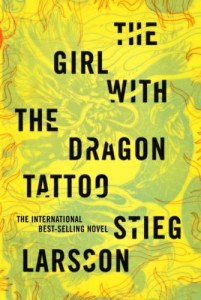
[*Spoilers for Book 1 but not for Book 2 ahead]
Firstly, there’s the English-language title, which Vertigo maintains, though the original Swedish title is, of course, Men Who Hate Women. The graphic novel series, more than the American film version, and perhaps more than the Swedish film series, emphasizes this theme with great consistency. In Book 1 from Vertigo, the narrative chapters are interspersed with what takes the place of single-issue covers or splash-pages in the form of artfully presented statistics about crimes against women in Sweden. The figures are sobering, and sometimes shocking, making American readers wonder how these stats compare to the USA. It’s a grounding in non-fictional reality that keeps reigning the story back into the society it depicts, reminding readers that the plot elements of DRAGON TATTOO may not be as fanciful as your average murder-mystery. Within the narrative of Book 1, also, smaller elements of characterization, setting, and back-story reinforce this theme even more fully than either film version. There’s a tension in the graphic novel between this overarching theme, which could well be the primary “message” of the story, and the massive gravitational pull of the appealing character, now pop culture icon, Lisbeth Salander. She steals the show at every turn. Hailed as a “super hero for grownups” by Vogue Magazine, getting sucked into her story becomes an experience of this abuse, but it’s easy to get caught up in her remarkable abilities and achievements and allow her origins in violence and trauma to fall by the wayside.

Book 2 of DRAGON TATTOO (set to be released May 7th 2013) shows the same focus, laudably, as Larsson’s series itself, and shows no signs of letting up as an investigation of gender-based crimes. Book 2 continues to cover ground contained in the first volume of the Millennium Series of books, the American film version (2011) and the two part Swedish film version of the first book, tracing the arrival of Lisbeth on the island to help shamed journalist Mikael Blomkvist piece together clues in the disappearance of another possibly wronged woman, Harriet Vanger 40 years previously. The grisly murders they investigate after deciphering coded information in Harriet’s journal reinforce the ongoing theme of the societal prevalence of violence against women.
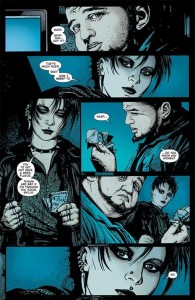
While all of the essential plot elements that deal with violence against Lisbeth (at the hands of her state-appointed guardian), and the murder cases she investigates are present in the film adaptations, Denise Mina, who adapts the graphic novels, and Leonardo Manco and Andrea Mutti, who handle the artwork, decompress the narrative enough to give equal focus to violence against women as to action sequences and romantic encounters. This changes the feel of the storytelling and alters the reader’s sense of what the story is really “about”. It is certainly a story about a hero, Lisbeth, and a crusader, Mikael Blomkvist, but it also a story about society, a story that is essentially “ugly”, as it was branded when it first reached American readers. To be fair, the Swedish film version comes closer to giving this theme more space to breathe than the American film version, but the graphic novel trumps them both in this regard.
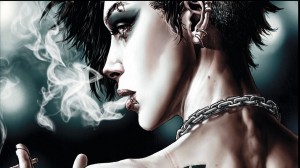
The graphic novel has another ace up its sleeve in terms of format in comparison to film: readers can control their own narrative pacing. But Book 1 goes beyond that allowance by including visual detail and more minor linking scenes in both Lisbeth’s and Mikael’s life that can provide more of a sense of the world that they inhabit. Manco and Mutti do an excellent job of loading panels with atmospheric elements that go beyond the utilitarian basics of storytelling. The Venger mansion is a relic loaded to the rafters with remnants of a past way of life, a kind of gracious opulence that can quickly turn into a sinister reminder of even worse times for social injustice. Giullia Brusco and Patricia Mulvihill’s colors on the graphic novel in Books 1 and 2 deserve special attention for contributing to this sense of differing social settings, from the more brash hues of Mikael’s life in the city, and later at the Venger mansion, to the more muted and moody world that Lisbeth inhabits. Brusco and Mulvihill’s wise decision to color code flashback sequences according to character works well, from Mikael’s sepia memories to Henrik Vanger’s blue-washed narratives of past events.
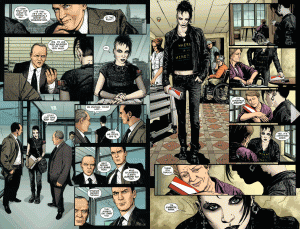
The tour de force, though, in colors, and also in lettering by Steve Wands, comes in Volume 2 when Lisbeth’s own flashbacks to recent traumatic events are depicted in a disjointed but overwhelming psychedelic repeat of phrases and images from her life, set in punk colors on a black background. Book 2 shows the same strengths as Book 1 in its unrushed pacing, attention to detail in setting, and also its commitment to establishing the psychology of its characters through preserving as much realistic minutiae as possible.
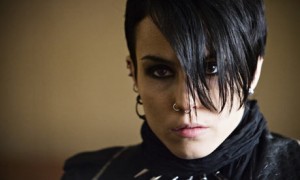
[Lisbeth Salander in the Swedish film version]
Though Manco and Mutti’s artwork is fastidious throughout Books 1 and 2, it feels most confident when depicting Lisbeth. This may be because of Manco’s “dark and gritty” style, Volume 1 touts, established through working on comics such as HELLBLAZER, is given full reign. It provides the character with quite a wow factor, boosting the sense that she’s a form of superhero, since the art style that surrounds her often stands in contrast to the more staid (but nevertheless threatening) environments she moves through. She frequently seems to explode onto the scene, even when walking quietly, and is depicted in a heroic lower than eye-level perspective. Her qualities, suggested and emphasized by the artwork, are even more apparent once she reaches the Venger estate. It’s as if her personality, and visually the art-style surrounding her, disturbs and undermines the heavily ornamented, and static, world of the past. While this visual contrast is established in Book 1, it’s even more apparent, and even more effective in Book 2 because of changing environments.

[American film version poster]
Book 1 of THE GIRL WITH THE DRAGON TATTOO was promising, setting up a lot of potential for telling a story in a way distinct from film versions that have been made, and though Book 2 by nature doesn’t have the same introductory force of Book 1, it does form a remarkably seamless development on the best features of the earlier volume from emphasizing violence against women as a governing, haunting theme, to including more detail about the lives of its characters than film versions have allowed. Book 2 also preserves and enhances Lisbeth’s hero status visually and narratively while guiding the reader deeper into the mysteries surrounding Harriet Vanger’s disappearance. If the prevailing sense created by the same team in Book 1 is “this could all be real”, Book 2 explores the implications of that assumption and so has the potential to be even more disturbing and more compelling in its revelations. If readers want realism that comes closer to the original novels by Larsson than the film versions, the graphic novels provide that alternative while still capturing the larger than life elements of the characters that have made the story such a phenomenon in the first place.
Title: THE GIRL WITH THE DRAGON TATTOO, Book 2/Publisher: DC Vertigo/Creative Team: Adapted by Denise Mina, Art by Leonardo Manco and Andrea Mutti/Colors by Giulia Brusco and Patricia Mulvihill/Letters by Steve Wands
Hannah Means-Shannon writes and blogs about comics for TRIP CITY and Sequart.org and is currently working on books about Neil Gaiman and Alan Moore for Sequart. She is @hannahmenzies on Twitter and hannahmenziesblog on WordPress.

By:
Heidi MacDonald,
on 2/21/2013
Blog:
PW -The Beat
(
Login to Add to MyJacketFlap)
JacketFlap tags:
News,
Reviews,
Comics,
DC,
Constantine,
Vertigo,
Dan DiDio,
Top News,
Hellblazer,
Peter Milligan,
Giuseppe Camuncoli,
Hellblazer #299,
Hellblazer #300,
Stefano Landini,
Add a tag
TweetOpening remarks are a prerequisite to talking about the final Vertigo issue of the imprint’s longest running series, the only from Vertigo’s original armada to last nearly so long, and a series which, totaling its original DC imprint and Vertigo lifespan, has lasted for 25 years. The series’ past and future are apt to be [...]

By:
Heidi MacDonald,
on 2/21/2013
Blog:
PW -The Beat
(
Login to Add to MyJacketFlap)
JacketFlap tags:
Comics,
DC,
Fables,
Bill Willingham,
Mike Carey,
HYPE!,
Vertigo,
Mark Buckingham,
Future Comics,
Top News,
Adam Hughes,
The Unwritten,
Add a tag
TweetShould that have been a semicolon instead of a comma in the title? Oh boy, the things I worry about when writing up Mike Carey news. Today! Vertigo have announced a bathful of new books, with an encyclopedia and anthology for Bill Willingham’s Fables coming later this year, followed by a full original graphic novel from the creative [...]

By:
Heidi MacDonald,
on 2/13/2013
Blog:
PW -The Beat
(
Login to Add to MyJacketFlap)
JacketFlap tags:
Vertigo,
Jason Latour,
Top Comics,
django unchained,
r .m. guera,
Reginald Hudlin,
Reviews,
Comics,
DC,
Add a tag
TweetFirst issues are easy – it’s the second issue where you get the proper measure of where a story is going, how it’ll play out, and what the style is going to be like. Of course, that isn’t really the case when you’re reviewing a comic which adapts a movie and follows the plot of [...]

By:
Heidi MacDonald,
on 1/30/2013
Blog:
PW -The Beat
(
Login to Add to MyJacketFlap)
JacketFlap tags:
DC,
Breaking News,
Fables,
Mike Carey,
HYPE!,
Vertigo,
Mark Buckingham,
Future Comics,
Peter Gross,
The Unwritten,
Comics,
Add a tag
TweetOr rather, as seen in this gorgeous Peter Gross/Mark Buckingham-drawn teaser image, the cast of Fables literally drag Tommy Taylor into their world. Vertigo have released this promo for May’s issue #50 of Mike Carey’s excellent series, kicking off an arc which will see the book head into the world of Bill WIllingham’s Fables, [...]

Executive Editor Shelly Bond
As expected, following the departure of Vertigo founder Karen Berger, remaining editors Shelly Bond, Will Dennis and Mark Doyle have been promoted, with Bond ascending to Executive Editor. After nearly 20 years at the imprint, its safe to say no one knows Vertigo better than Bond. Despite all the eulogies over Vertigo when Berger left, it appears the imprint is very much alive, although obviously its direction was already subtly shifting. We’ve been hearing that the call has gone out to creators for more pitches, so you might be seeing some interesting things from Vertigo in 2013.
“Shelly Bond has been promoted to Executive Editor of the Vertigo imprint for DC Entertainment. Joining Bond in her new leadership role are Will Dennis, who has been promoted to Group Editor, Vertigo and Mark Doyle who has been promoted to Editor, Vertigo. All three staffers have spent years under the guidance of outgoing SVP & Executive Editor Karen Berger, creating a continuity in editorial experience.
“’I've been incredibly lucky to have worked for many years with these three smart and talented editors. Shelly has been by my side since the beginning of Vertigo, so I couldn’t be happier about passing the baton to her,’ Berger said. ‘She brings so much creativity, passion and professionalism to everything she edits with special note to the wildly successful FABLES, which she launched and has overseen for over 10 years. Will is a highly regarded story editor of many critically acclaimed series including 100 BULLETS, DMZ and SCALPED and has procured many European and South American artists for our titles. Mark has a great eye for new writing talent, and his avid interest in up-to-the-minute fiction has been a real asset to the line. I look forward to reading many great comics and graphic novels from these three for many years to come. Vertigo is in the best of hands.’
“Bond began her career at Vertigo in 1993 as Assistant Editor. Her unique pop culture sensibility and love of all things British – plus a knack for discovering new, uncompromising and inspired talent – helped launch some of the most beloved Vertigo series and OGNs, including FABLES, FAIREST, THE INVISIBLES, LUCIFER, HEAVY LIQUID, SLOTH, iZOMBIE, AMERICAN VIRGIN, DEADENDERS, HOUSE OF SECRETS, YOUNG LIARS, THE SANDMAN: ENDLESS NIGHTS and DEATH: AT DEATH’S DOOR. The list of talented creators Bond has worked with over the years is equally long and impressive, including Michael Allred, Mark Buckingham, Mike Carey, Howard Chaykin, Becky Cloonan, Neil Gaiman, Peter Gross, Gilbert Hernandez, James Jean, Phil Jimenez, Peter Milligan, Grant Morrison, Paul Pope, Steven T. Seagle, Jill Thompson, Bill Willingham and many more.
“Before DC, Bond was a video/film editor and talent agent. She also served as the editor for THE ELEMENTALS – a comic book by Willingham. The friendship and working relationship continues to this day, as FABLES celebrates 10 years of publication.
“‘It’s been a great privilege, both personally and professionally, to work with Karen Berger since Vertigo’s inception,’ says Bond. ‘I look forward to honoring her legacy by continuing to push the imprint to arresting new heights ably abetted by a fiercely talented editorial team. Expect nothing but the deft storytelling, incomparable artistry and the bravado that has made Vertigo an industry leader.’
“Dennis has had a long and critically-acclaimed editorial career at Vertigo and DC Comics, which saw him form long-lasting relationships with some of the most renowned creators in comics, including Jason Aaron, Brian Azzarello, Lee Bermejo, R.M. Guera, Jim Lee, Denise Mina, Eduardo Risso, Brian K. Vaughan, Brian Wood and the legendary Joe Kubert. Dennis has edited a number of award-winning ongoing series and special projects for the imprint, such as 100 BULLETS, SPACEMAN, SCALPED, THE LOSERS, PRIDE OF BAGHDAD, DONG XOAI: VIETNAM 1965, THE GIRL WITH THE DRAGON TATTOO, NORTHLANDERS and DMZ to name a few. Additionally, Dennis has edited many best-selling projects outside of Vertigo, including the JOKER graphic novel, Azzarello and Lee’s SUPERMAN: FOR TOMORROW and the current BEFORE WATCHMEN mini-series.
“A lifelong fan of crime fiction and music, Dennis began his career at Vertigo as Assistant Editor. Prior to Vertigo, Dennis worked at a boutique music and film publicity agency. One of his first jobs was at his local comic shop after college. Dennis points to his current gig as ‘the best job I’ve ever had.’ While he’s worked with some of the best and brightest talent the comic book industry has to offer, Dennis says few come close to the experience of working with one of comics all-time greats, writer/artist Joe Kubert, describing it as ‘a dream come true.’
“Doyle began his career at Vertigo as Assistant Editor in 2006. Always on the lookout for new talent, he launched Scott Snyder’s first ongoing comic book series AMERICAN VAMPIRE with Stephen King and award winning artist Rafael Albuquerque in 2010. He has worked on such titles as SWEET TOOTH, THE NEW DEADWARDIANS, NORTHLANDERS, THE EXTERMINATORS and AMERICAN SPLENDOR by Harvey Pekar and currently assists on the current BEFORE WATCHMEN mini-series.”
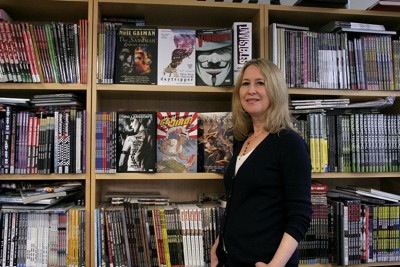
It would be hard to overemphasize the influence that Karen Berger had on the comics industry. I’m sure some people will argue her influence only extended to the mainstream comics industry, but it would be hard to find too many young adults reading comics in the from the 80s on who didn’t find something to enjoy in somewhere in the line up of Swamp Thing, Sandman, Hellblazer, Animal Man, Doom Patrol, Shade The Changing Man, The Invisibles, Transmetropolitan, Preacher, 100 Bullets, Fables, Y the Last Man, Scalped and beyond. That’s an insanely powerful line-up of iconic comics series and characters, and the creators who worked on the books were a who’s who of the engaged, inspired and imaginative creators of the era. In the tweet above, Roberson put Berger, whose exit from DC after 33 years was announced yesterday, in the proper company. Like Gaines and Lee, Berger excelled at the tricky business of matching story and art from disparate sources. You could add Julius Schwartz and Archie Goodwin to the list of the great editors, but they didn’t change the landscape the way Gaines, Lee and Berger did, terraforming it into a new thing with a new viewpoint.Julian Darius at Sequart has a succinct history of Berger’s career at DC, and he nails the rite of passage for just about everyone who wanted to write comics for the last 20 years: “getting a book at Vertigo” became universally known as the way to make your mark on comics.
Vertigo soon came to be regarded as a proving ground for many of the industry’s best writers. The imprint also became known for limited ongoing series in the model of The Sandman, although now creator-owned. Such a series came to feel like a rite of passage in a major writer’s career, increasingly even the case for writers Berger hadn’t personally recruited. Such series, all published by Vertigo, prominently included Grant Morrison’s The Invisibles, Garth Ennis’s Preacher, Warren Ellis’s Transmetropolitan (after moving to Vertigo from DC’s defunct sci-fi imprint, Helix), Mike Carey’s Lucifer (a follow-up to The Sandman), Brian Azzarello’s 100 Bullets, Brian K. Vaughan’s Y: The Last Man, Bill Willingham’s Fables (although not designed to be limited in duration), and Jason Aaron’s Scalped. Even when one of these series didn’t sell particularly well, it almost invariably came to be listed as one of the first works mentioned in connection with that writer. Sometimes, these series helped catapult a writer to A-list status; in other cases, they were concurrent with such a rise, helping to legitimize that writer as a serious mind capable of serious works. Such was the power of Vertigo at its height.
With the support of then DC publisher
Jenette Kahn and especially president
Paul Levitz, Berger was able to carve out the dark, striking horror of Swamp Thing and imaginative fantasy of Sandman into a whole line of books—and did it offering creators a piece of the pie in an equitable publishing model that far outlasted similar efforts. Even with writers whose styles were as disparate as the above, the adjective “Vertigo-esque” was immediately understood by everyone who had come near a comic in the last 20 years. “Dark and edgy” soon became meaningless buzzwords, but there would be something gothic, something about expanding consciousness, blurry sexuality, disgusting maggots and decay, a hidden world. The earliest books of the proto Vertigo took bland superhero characters and made them angsty explorers. It was grown up (if often melodramatic) and it was very much the way Berger envisioned things should be. Writing for Vertigo meant you had to be enormously literate about not only comics but literature and science and weird, unexplainable things…and it was all on the page. At its best Vertigo meant intelligent comics for intelligent readers.
It was an extraordinary run, and twitter was filled with tributes:
Karen was my boss for two years, from 2000-02, and it’s safe to say that working at Vertigo was not a good fit for me, and we often clashed. We both cared enormously—but about different things. That said, they were mostly philosophical differences and I didn’t lose sight of Karen’s enduring legacy as an editor or the fact that she was, at heart, an incredibly nice and thoughtful lady. I was very pleased earlier this year when she agreed to appear on my panel about editing comics at New York Comic Con, and enjoyed hearing her talk about some of her most recent graphic novel projects. Mariah Huehner, who was an intern and assistant editor during my tenure, has her own remembrance of working at Vertigo:
Of the many things I noticed about Karen Berger, the high level of respect and esteem in which the other editors and creators held her was the most obvious. People -liked- working with her. They respected her opinions even when they disagreed, and she was a huge reason why people wanted to work there. Creators felt understood and encouraged, while also challenged and held to an extremely high writing standard. Her story notes were always simple and insightful, asking questions, never criticizing, but not letting things slide either. She made sure the story worked and helped the creator tell it, without trying to write it for them or push an agenda. She clearly understood how to be a story collaborator and agent, without ever taking anything away from the writer or artist responsible for its creation.
Although I didn’t work with Karen directly most of the time, she would encourage my writing and ask my opinion on pitches from time to time. She was always very fair in her reviews of my work and seemed to really believe I had the ability to be a good editor in my own right. It meant a lot. Before working at Vertigo I had somewhat taken my writing abilities for granted, even though I loved to do it. During my tenure there I was encouraged to do interviews, press releases, and copy a great deal, and learned a lot about what worked and what didn’t.
If all this has an elegiac tone to it, it’s that for all it’s huge success, influence and multiple Eisner Awards, it’s impossible to see Vertigo going on without Karen Berger, or even if DC and WB have any interest in continuing, or what that would mean. While news of Berger’s departure was stunning, it surprised no one who had been paying any attention, and over the last 12 months the demise of Vertigo and Berger’s potential exit were a staple of the rumor mill.
Rich Johnston has a succinct write-up of
the downward spiral of the last few years: from having signature characters Swamp Thing and then Constantine taken back to the DCU, and the end of Vertigo’s Hellblazer, to be replaced by a DCU Constantine. Only yesterday,
Peter Milligan, the last of the Vertigo’s elder gods to still work on books regularly, was talking about
the end of Hellblazer in curt, pained answers:
Was the end of the series a surprise to you, or is this something that has been in the works for some time?
Like I said, that my run was coming to an end was no surprise. I’d been thinking about it for a little while and thinking of my “out.” I had a strong suspicion that the series would end, but when it came, it came suddenly. Like death.
Are you surprised at all by the outcry from creators and readers alike that are angered/upset/dismayed about the end of “Hellblazer?”
No. Not surprised at all.
As the latest DC sales chart which is going up later today will show, sales had eroded immensely and looking at the bleak numbers—and without the idea of developing creators and properties to support it—the idea of a Vertigo imprint doesn’t make that much publishing sense any more from a business standpoint. Aside from the fact that a huge chunk of the Big Two comics writer of note for the last 20 years got “discovered” at Vertigo.
Scott Snyder, the hero of the New 52, was a Vertigo find;
Jeff Lemire was an an acclaimed, award winning indie cartoonist, much respected in his native Canada, but it’s fair to say Sweet Tooth got his name on the board at DC. Besides the Brit crew, writer who blossomed at Vertigo include
Azzarello, Brubaker, Aaron, Brian Wood, Brian K Vaughn, and so on. Without Vertigo to give talent a platform to really show what they can do, the scouting trips to Image are already underway. But will they really be needed? For me the death knell for Vertigo came when it was announced that Scott Snyder would be taking leave of American Vampire, his series for Vertigo, to catch up on Batman and Superman.
Here’s the entire story, courtesy of Newsarama:
Nrama: So this hiatus you’re taking is definitely not going to become the end of the series. You’re setting up what’s happening next.
Snyder: Yeah, I cannot emphasize enough how absolutely firm we are in terms of how temporary this hiatus is.
[snip] We know we’re only taking about six months off from the series, between us. That might mean a little longer between issues that the readers see. So what I mean is that Rafael is only taking off six months after he finishes #34, and I’m only taking about six months off from writing American Vampire — maybe even less. For me, it’s mainly so I can get ahead on Batman and Superman, and I can also get ahead on The Wake with Sean Murphy. Part of it is needing to be able to stagger these books to make sure I’m able to give 100 percent on each one.
The only thing that would really make me not want to do the books is if I couldn’t give everything I have to each one. So I’d rather stop doing a book for a few months than put out a book that I don’t feel 100 percent about.
And by the time we come back, I’ll essentially be way ahead on Batman and Superman. I’m ahead now, but I’ll be way ahead, hopefully. And I’ll be far enough into The Wake, because Sean [Murphy] has a really meticulous drawing style, which is incredible and I love, that it will be staggered by the time we come back. What I mean is, I’ll be far enough ahead on the books that it will be almost like having two books and not four at that point.
Although Snyder’s new Vertigo book (even typing that seems so tentative now) wath
Sean Murphy, The Wake, will doubtless come out, considering what a valuable player he is for the DCU, but it is’t hard to imagine that becoming more of an “Icon” type thing. Others have an even more pessimistic view.
Stewart has been drifting away from superhero work for a while, and without a champion, a third volume of a quirky book about a guy in a scuba suit does sound rather a reach for the modern corporate comics company.
There’s still the “Before Sandman” project, a new Neil Gaiman written Sandman tale, announced at the last San Diego Comic-Con which was to cap off the 25th anniversary of Sandman festivities. The artist on this project, JH Williams III, is wistful (and surprisingly candid) about the project’s completion,
I find the timing of her departure from DC to be sadly ironic, in that next year when Karen says her final goodbyes to the company it will also be the 25 year anniversary of Sandman, one the titles that sort of started the whole thing (to which there is a brand new Sandman project on the way for this anniversary that I’m to start illustrating very soon). Sandman issue 1 was published in October of 1988 but dated January 1989, which helped lead to the formation of Vertigo under Karen’s direction, next year will bring the 20th anniversary of the legendary imprint. Having known Karen for many years and doing a few things for vertigo here or there, I had long been looking forward to working with her at a much closer level on this new Sandman project. So while excited over Sandman, its become bittersweet as her involvement will be going away. I’m a bit uncomfortable over it, actually. But it is what it is. I know I will not help but think of her that first day I put pen to paper, on that very first page Karen will be there in spirit.
I was also seriously disappointed when I’d heard about the demise of Vertigo’s Hellblazer recently announced, in favor of transitioning the lead character into the DCU entirely, not an idea I’m overly fond of. As a longtime reader of Hellblazer it was disheartening. I felt as if Vertigo was beginning to slowly be sucked dry, it’s life’s blood drained away. And with the departure of Karen Berger I have to admit that I’m feeling even more disheartened. And speaking as bit of a fan here, not an industry professional, I’m feeling torn between a struggle of anger about some things and rather optimistic for what the future may hold for Karen, and in turn for us as readers. As a creative editor Karen has something to say, always has, and I’m certain her voice will rise up out of the din and resonate with something new. And when that voice does sound, in whatever form that may take, I know I’m there to listen.
So what then of the future? For Karen Berger’s future, although everyone wants to see her take on some new project, it’s unknown if she has a no compete clause the way many departed DC execs do. Also, she’s 54 and has nothing to prove. A boutique imprint at a major publisher like Random House maybe? Certainly this will become an interesting topic for the hot stove league.
As for Vertigo, the line itself, there will be “assisting in the transition to a new leadership team which includes veteran staffers whom she has mentored over the years,” a rather mysterious statement in the official PR that comes off like asking Rex Ryan who’s starting at quarterback for the Jets next week. This had to be in the cards for a while and yet Berger was making plans for new projects as recently as last week, according to one freelancer I spoke with.
As for who those “veteran staffers” might be, on is, obviously, there’s Shelly Bond, who was made Group Editor nearly a decade ago and continues to oversee the successful Fables franchise. Another is Senior Editor Will Dennis, whose work on many a DCU project, including Before Watchmen, leaves him in a strong position. Mark Doyle, who signed up Scott Snyder, would be another name in the mix. I’ve heard a few other, more surprising names, however. We’ll have to wait and see.
While any of these fine editors could carry the torch forward, the real, brutal question is…is the Vertigo imprint even needed any more? Johanna Draper Carlson lays it out:
It’s very possible to envision an American comic industry without Vertigo, and many people are. Although DC’s press release indicates intent to continue the imprint, as many people started wondering after the announcement of the cancellation of Hellblazer last month, it’s an open question whether Vertigo is needed at all these days, or whether it had a future under the Warner/DC Entertainment regime with or without her. There’s no longer any need it fulfills for the company or creators, as the main DC line now publishes mature readers material and creator ownership is easier to get elsewhere. I don’t know whether Berger intends to change industries or find something else to do in comics or retire, whether she’s tired of what DC has become or simply feels like a change, whether the company made her an offer she couldn’t refuse or suggested she leave before they pushed or were tired of paying that many vice presidents. I hope we hear more from her next year. She had a long and storied career, responsible for all kinds of major accomplishments it’s too late for me to list accurately. On a political level, she was one of the most visible women in a high-ranking position at a comic company, and losing her feels to me like another sign of how female-unfriendly corporate American comics have become.
At the most brutal level, there is no place in corporate comics for creator owned comics. That is just a fact. And on another level, Vertigo’s mission has become almost unnecessary. It isn’t a choice between Hawkman and X-force any more. It’s a choice between Hark a Vagrant and XKCD, Saga and The Walking Dead, Ganges and Sailor Twain, Building Stories and The Freddie Stories.
Vertigo, the brand, is still a valuable name on the spine of many of DC’s best selling backlist books, but how long will a book publishing program remain important to Warner Bros? In the face of declining sales, Vertigo tried to relaunch a bunch of monthly titles earlier this year—most recently with Saucer Country and New Deadwardians and so on and…well, that was it. The graphic novel program launched years ago and still has books in the pipeline, but has had dwindling internal support from all signs. Would the market have supported these projects with a new imprint, like DC Blaze or something? Corporate comics don’t do new too well.
All of this will unfold, privately and publicly. But it will all be different. In all of the outpouring of comments today, the one overriding feeling was that this was the end of an era. And you know, it was a pretty awesome era.
I’ll end this, Death of Speedy style, with a video from 1985 of young Karen Berger and young Alan Moore taking about Swamp Thing. It was all so innocent then, but the stories will endure.

By:
Heidi MacDonald,
on 11/30/2012
Blog:
PW -The Beat
(
Login to Add to MyJacketFlap)
JacketFlap tags:
Top Comics,
Hellblazer,
Peter Milligan,
Reviews,
Comics,
DC,
Marvel,
IDW,
Alex Ross,
Vertigo,
My Little Pony,
Dynamite,
chris roberson,
Katie Cook,
Gambit,
Add a tag
This week saw a number of big comic releases from Marvel and DC, but who cares when this was the week My Little Pony: Friendship is Magic #1 came out? PONIES, you guys! Ponies all over the place.
This week I’ll be reviewing My Little Pony: Friendship is Magic #1, Hellblazer #297, Gambit #6 and Masks #1
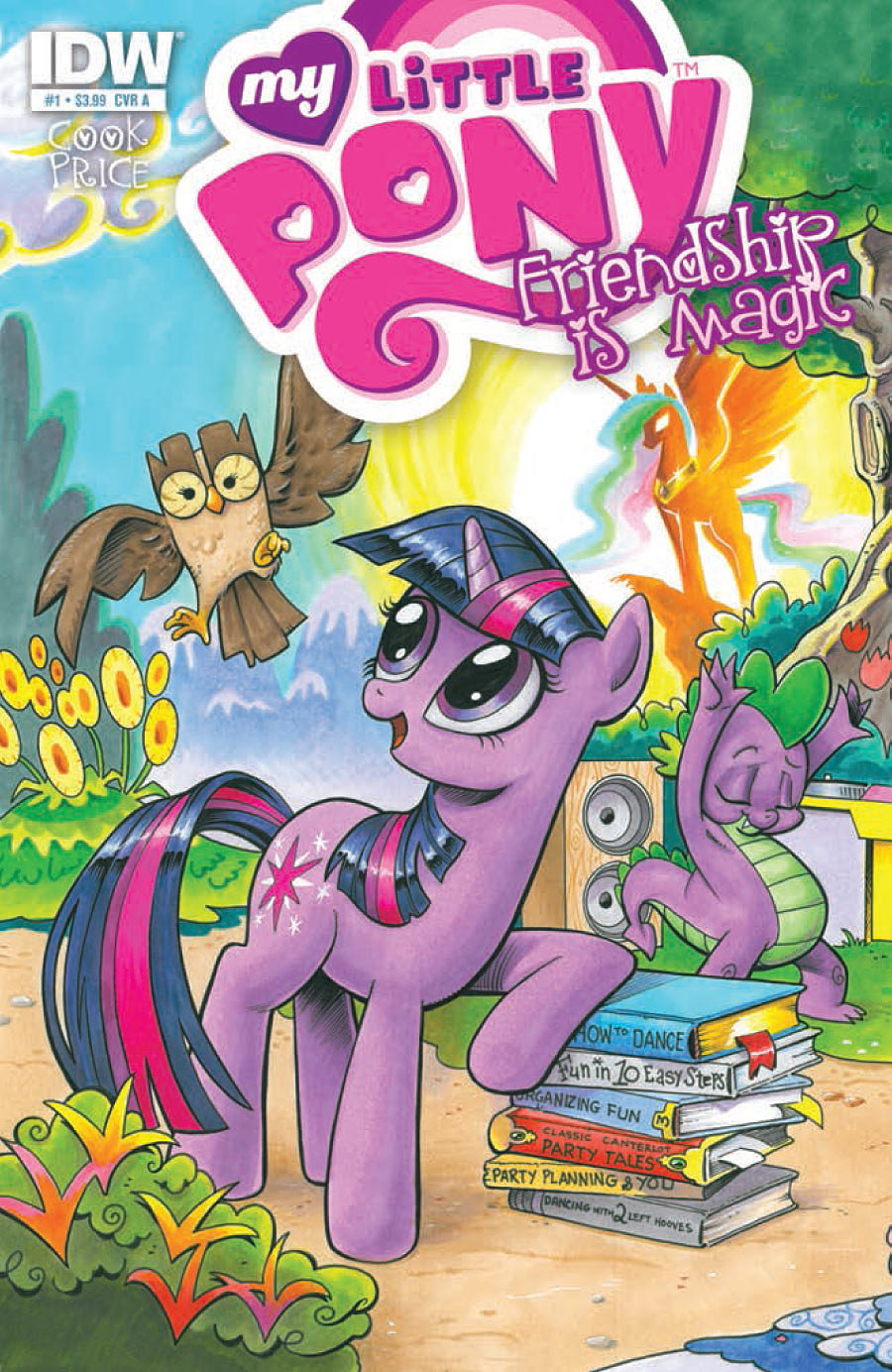
My Little Pony: Friendship is Magic is the unexpected mass-market hit cartoon series which came out of nowhere to hit every demographic. The series grew such a strong fanbase, in fact, that pre-orders for this spin-off comic series went ballistic, and Katie Cook and Andy Price were left with a smash hit before anybody read a word or saw a single hoof. Issue #1 of IDW’s series doesn’t pay much lip service to new fans, instead asking them to immediately catch up on a fast-paced opening story which races around a large cast of diverse and well-characterised ponies at breakneck speed. Jokes and puns and visual gags fly out from all angles, with almost every one landing. And amazingly, the creative team manage to make the book accessible without pausing to explain anything about the world the characters live in.
Cook is primarily a great humorist, and her voice for the book is immediately charming and entertaining. Whilst it’s hard for this “no-ny” (I knew nothing of the series before reading this book) to know how well she matches or moves away from the voice of the cartoon, I was pretty struck by Cook’s ability to string along an endless succession of gags whilst retaining exposition and story. She’s matched by lovely art from Andy Price, who refuses to draw stock figures from the cartoon and instead invests his own sense of life into the various galloping protagonists. His use of layout is rather spectacular, with thought given to how the panels stand alongside each other and progress the story. This isn’t spectacle for the sake of spectacle, but rather an intelligent use of page space and structure.
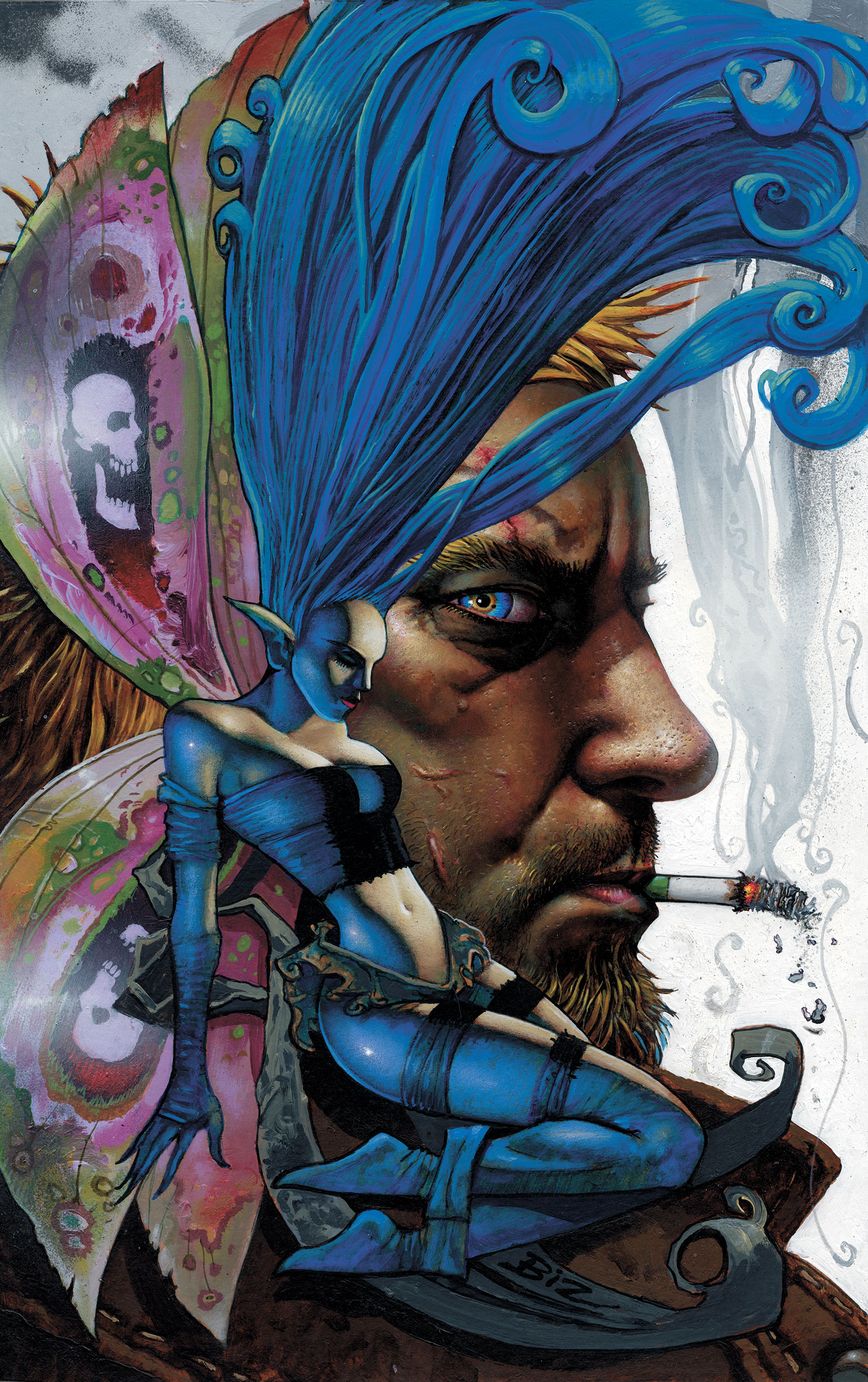
A lot of people were very very upset when DC recently announced the cancellation of Hellblazer, but let’s celebrate what we have left – three more issues – rather than mourn a book we might not actually read. Hellblazer has been in the hands of creative team Peter Milligan, Giuseppi Camuncoli and Brian Buccellato for a while now, although this issue is finished by Stefano Landini. The most recent issue concludes the ‘Curse of the Constantines’ storyline, which seems to finish off a number of Milligan’s dangling plot threads regarding Constantine’s family, especially his sister. Being from Liverpool himself, Milligan has proven to be one of the best Constantine writers since also-Scouse Mike Carey, with both being able to effortlessly write lines for the character which are both authentic and very, very funny.
With this being the last of a five-issue storyline, Camuncoli’s art is flagging a little here. Although he takes care to distinctively shape the big moments and standout sequences, some of the pages feature scratchier art which Buccellato can’t do much with. The story here does feature a little bit of a Milligan anticlimax, something the writer sometimes falls prey to. Whilst Constantine’s plan to save the day is funny, it is very slight indeed, and requires a leap of characterisation for the Eva Brady character. Regardless, the grasp on dialogue is spot-on and more than enough to carry the day here, setting Constantine up for a final storyline which gives him a fresh break from the past, and leaves the future unpredictable and exciting for the character.

James Asmus‘ Gambit series has been growing in confidence after a strong opening issue turned into a slightly wobbly first storyline. Each issue of the book has featured some kind of heist, and it’s to Asmus’ credit that heist 6 feels just as unpredictable as heist 1. We’re now in the middle of a storyline where the thief finds himself forced to steal from Pete Wisdom and the British MI13 team (although only Faiza Hussain also appears in the storyline so far). Asmus does light-hearted thrills nicely, although the artwork here seems to be a classic case of a Marvel title getting rushed by scheduling. Diogenes Neves is capable of better work when he isn’t under the pressure he seems to be under here, and indeed he shares art duties here with Al Barrionuevo after only one issue by himself.
It’s a shame that Marvel have recently taken to battering their artists with tighter and tighter deadlines, as it’s led to a rise of fill-ins and rushed pages. There’s a splash page here where we see the insides of MI13′s armoury, a page which was clearly intended to be filled with detail and exciting. However, it looks bare, with a few guns and bits of scrap metal lying around. Give Neves time to draw this page, I bet he’d have made it something exciting to look at. Without that time, his page does a disservice to Asmus’ story.
However, Asmus does seem to be rapidly building his world for the book, with a rising cast and some nice character moments for the main character. He doesn’t write anyone as an idiot in order to make somebody else look good – Pete Wisdom, Faiza Hussain, Gambit and Cich are all juggled nicely between each other here. The Gambit character has also benefited hugely from the retooling Asmus has given him, with a better direction, personality and motivation than he’s had in a decade. The best sequences in the issue are the ones with Gambit in them, as the focus, and that’s because Asmus has done such a great job of making the character exciting to be with again.
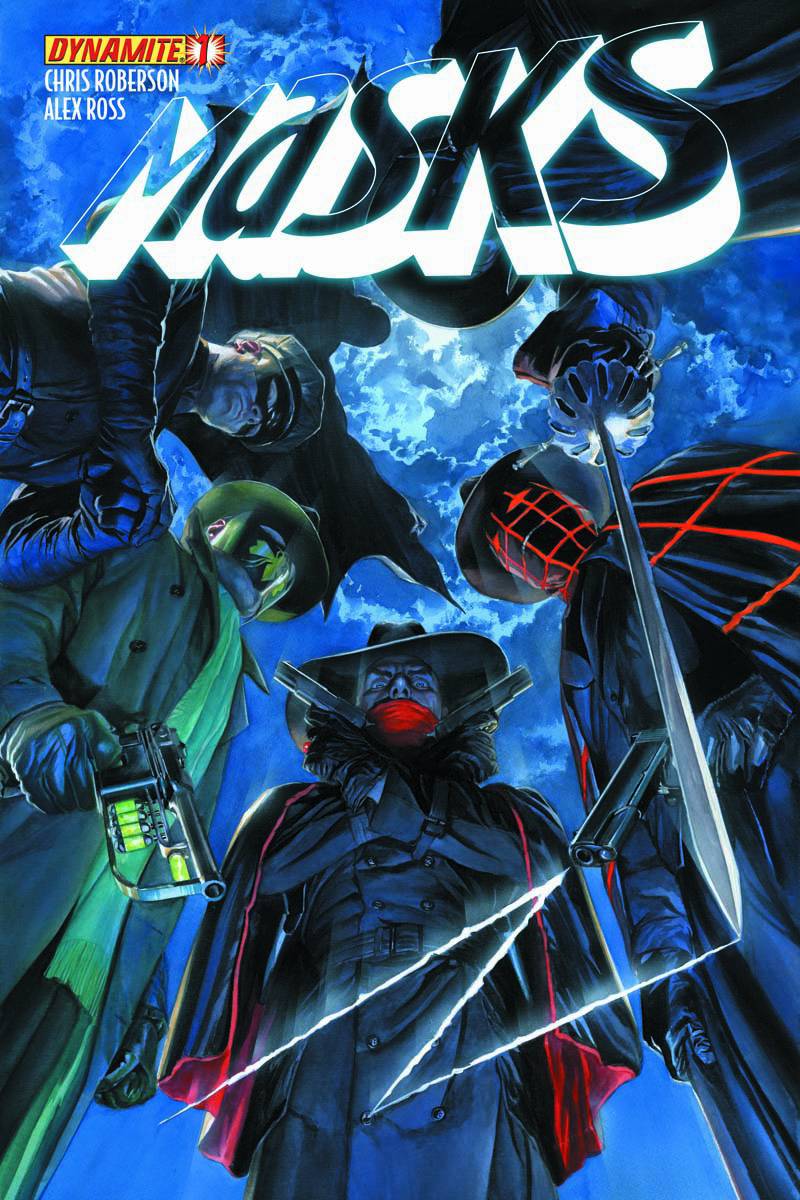
It appears that the pre-sales for Dynamite’s team-up book Masks have been stonking, and a massive success for the company. Written by Chris Roberson and with this first issue painted by Alex Ross, the series teams up Zorro, The Spider, The Shadow and The Green Hornet for a pulp nostalgia trip. Being somewhat unfamiliar with all the characters, this first issue left me a little confused, but with a sense that Roberson is heading somewhere good. Green Hornet provides the perspective for readers, as we follow him interact with first The Shadow, and then the rest of the heroes. I’m not entirely certain what Zorro’s role in the book is at present – he might have appeared, but I really can’t tell if that was him or not. The introduction of The Spider is also blatantly tacked on, albeit in a hilariously camp manner that I couldn’t help but enjoy. Roberson seems to be having a lot of fun here, and Ross is clearly having a ball.
Roberson allows for the reader to view the story as a camp homage just as much as he writes a pulp narrative, here, balancing the two different styles neatly. The story is simultaneously involving and completely ridiculous nonsense, but in the most enjoyable manner possible. He also makes sure to write for Ross, whose painted pages are far less static than you might expect. The fight scene towards the end is a particularly well-done sequence from the pair, while the conversation sequences aren’t overshadowed by dead-eyed staring from everybody involved – as can be the case for painted work. Ross reminds that he’s an excellent storyteller as well as painter with this issue, and it’ll be interesting to see how the story progresses beyond here. It’s a qualified success, in that it’ll play far better to fans who already love and know the characters than it will bring in and keep new readers.
– As a final note! Let’s take a moment to praise letterer Cory Petit, who is currently working on X-Men Legacy. This is a book with a myriad things happening in the word balloons, and Petit’s ability to juggle it all is pretty incredible. It’s probably one of the most demanding comics I’ve seen, and he manages to take everything Si Spurrier throws at him — and make it work.
Bursting into today’s Before Watchment panel with apparently nobody’s permission, 9ft filmmaker Quentin Tarantino announced – and given his ability to talk, is probably still announcing now – that he will be writing a 5-issue miniseries for DC’s Vertigo imprint, based on his upcoming film Django Unchained.
About a slave who becomes a bounty-hunter in order to please Christophe Waltz/gain his freedom, the film stars Jamie Fox, as the crowd assembled at the panel are probably being told about right now. There was very little sign that DC knew Tarantino was going to announce this so soon, but here’s a rough transcript of his speech thus far:
One of the things I’m really excited about is that Django Unchained is a big epic, and when I write these epics there’s a lot of stuff that doesn’t make the movies I’m always stuck with adapting my unwieldy script into a movie every day so what’s really cool with doing this is as a comic book is it’s the entire script all the material that didn’t make the movie will all be part of the piece I’m really excited about that, so be looking out for Django Unchained in a comic book store near you! ….And thanks for letting me barge in on your panel!
Look for DC to scramble together an official press release later tonight. Oh Quentin!
View Next 4 Posts

































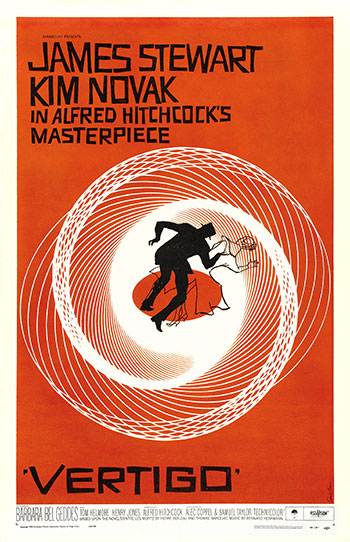


























Being a cultural historian by day and a nerd by night, this piece was right up my bailiwick – a lovely piece of journalism (I was expecting a simple recap of situation with the show’s status, so I was pleasantly surprised to find such an analysis of modern fan campaigns). As a big fan of Constantine myself – among everything else the show does well, I’m particularly fond of how the writers balance issues of faith within a network horror/fantasy program – I’m pulling for the success of the #saveconstantine campaign!
Hope they pull the plug on this show. What did Karen Berger said? “Constantine Lite”. Not even that, just mediocre television.
Constantine pulled 3.3 million viewers on Friday. For the cost of the show, that’s way too low a number for it to survive. Fan campaigns are great, but if not enough people watch the show, it gets pulled. Just ask “Selfie”.